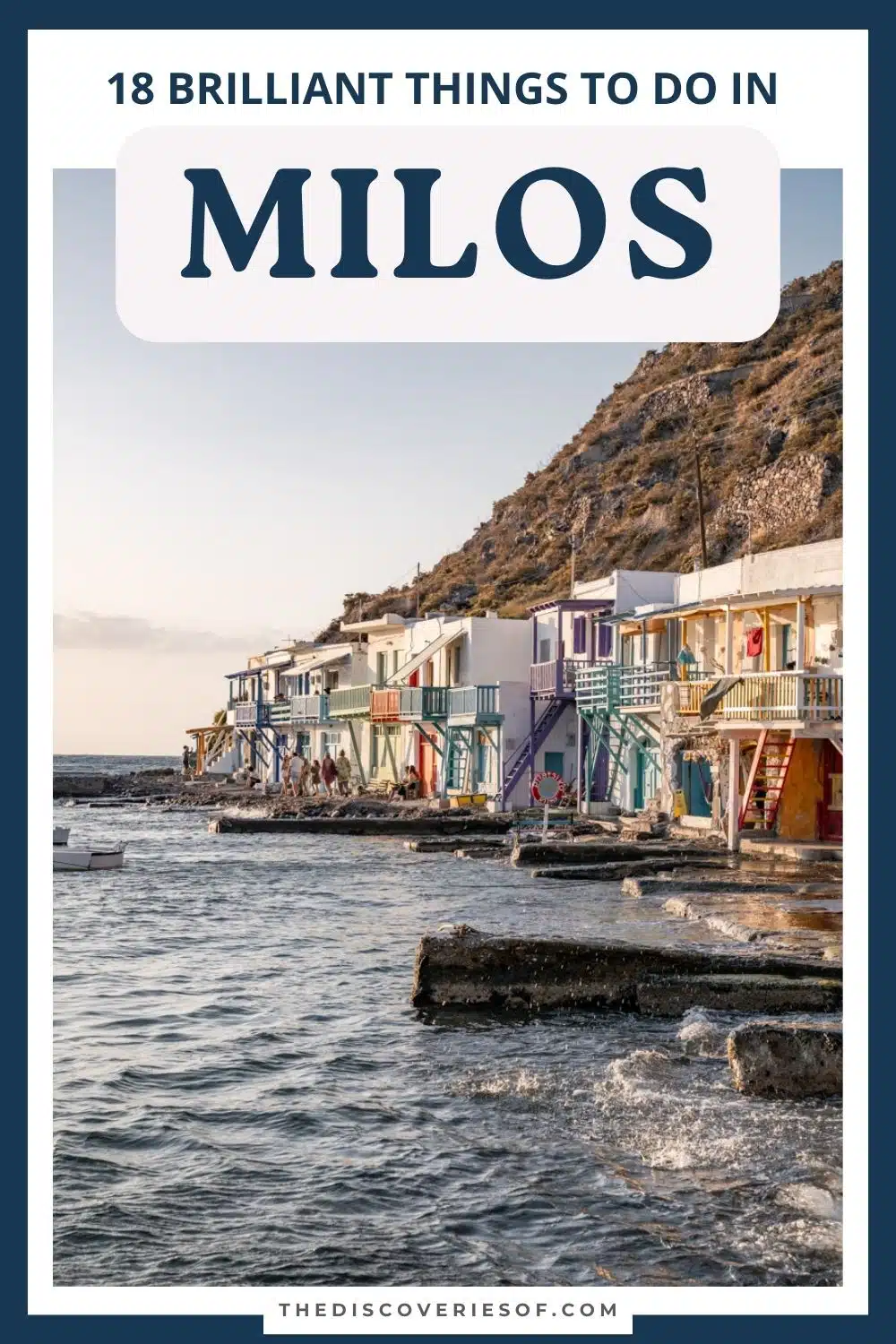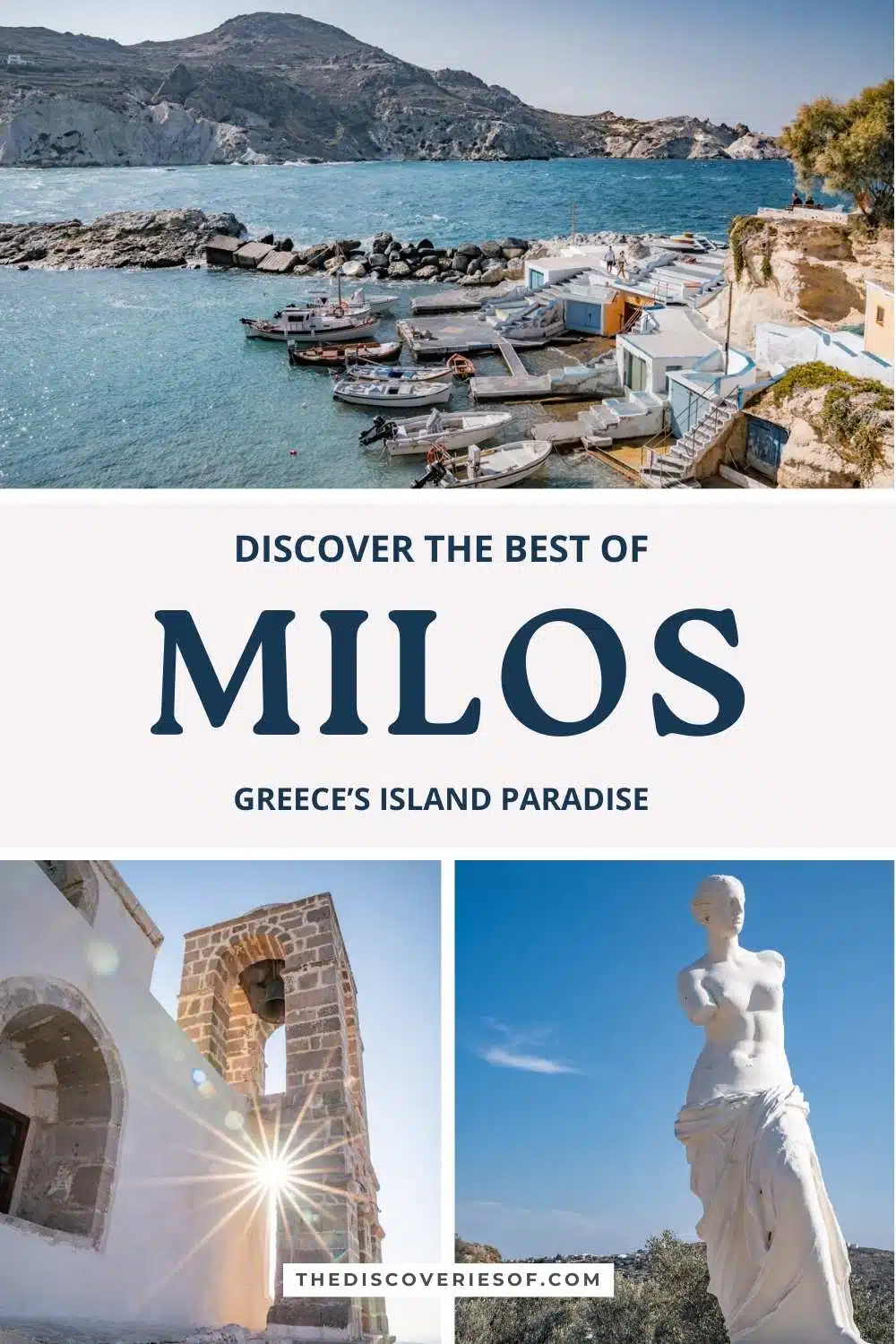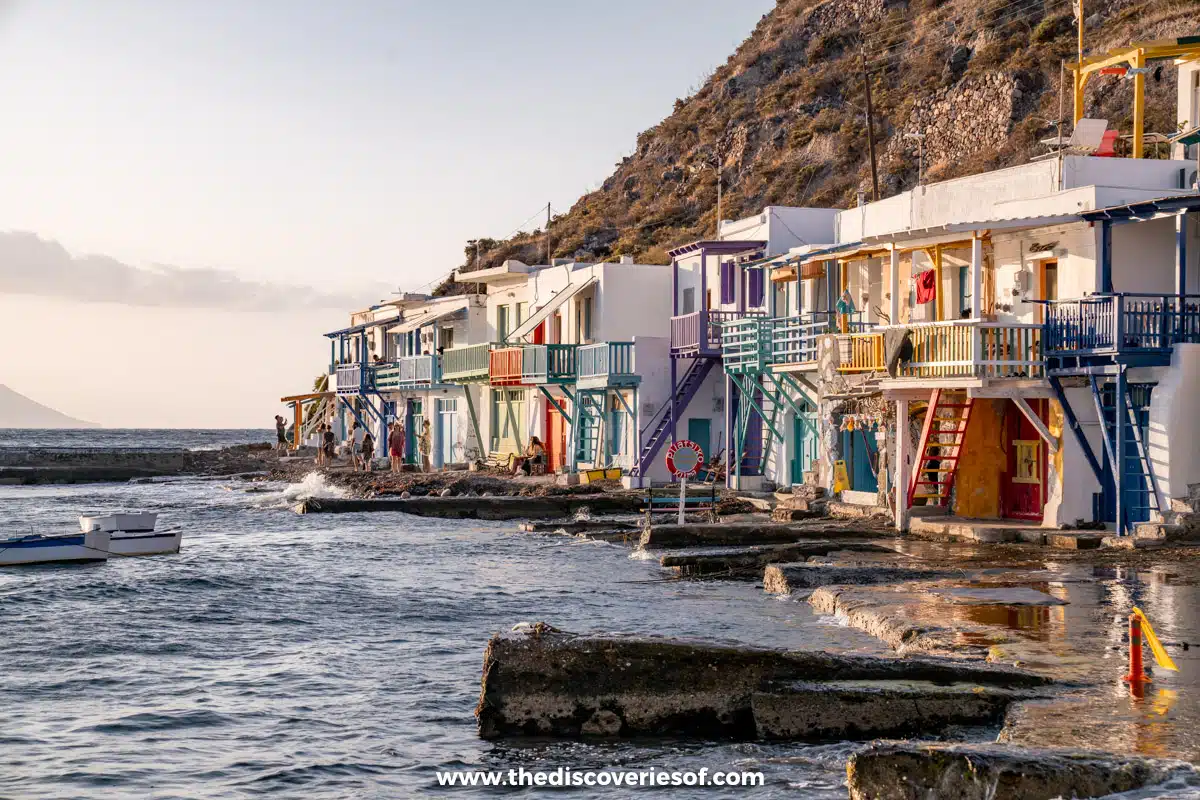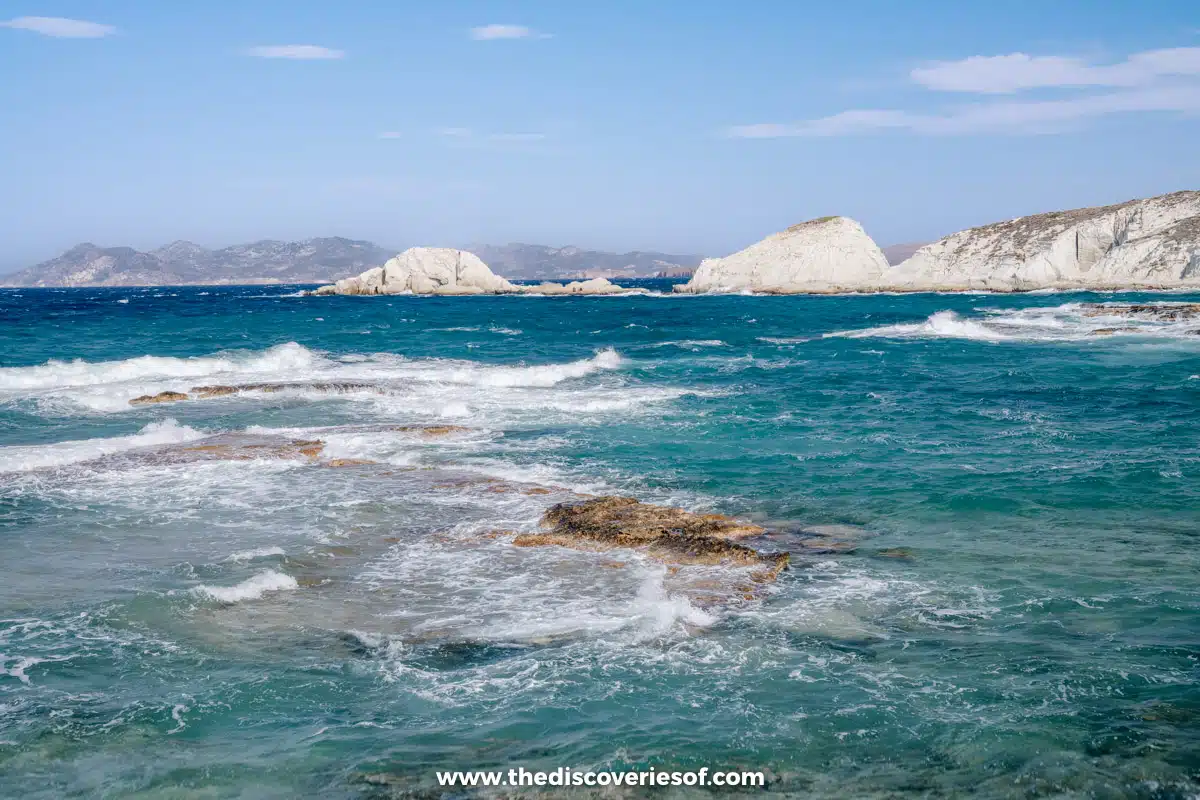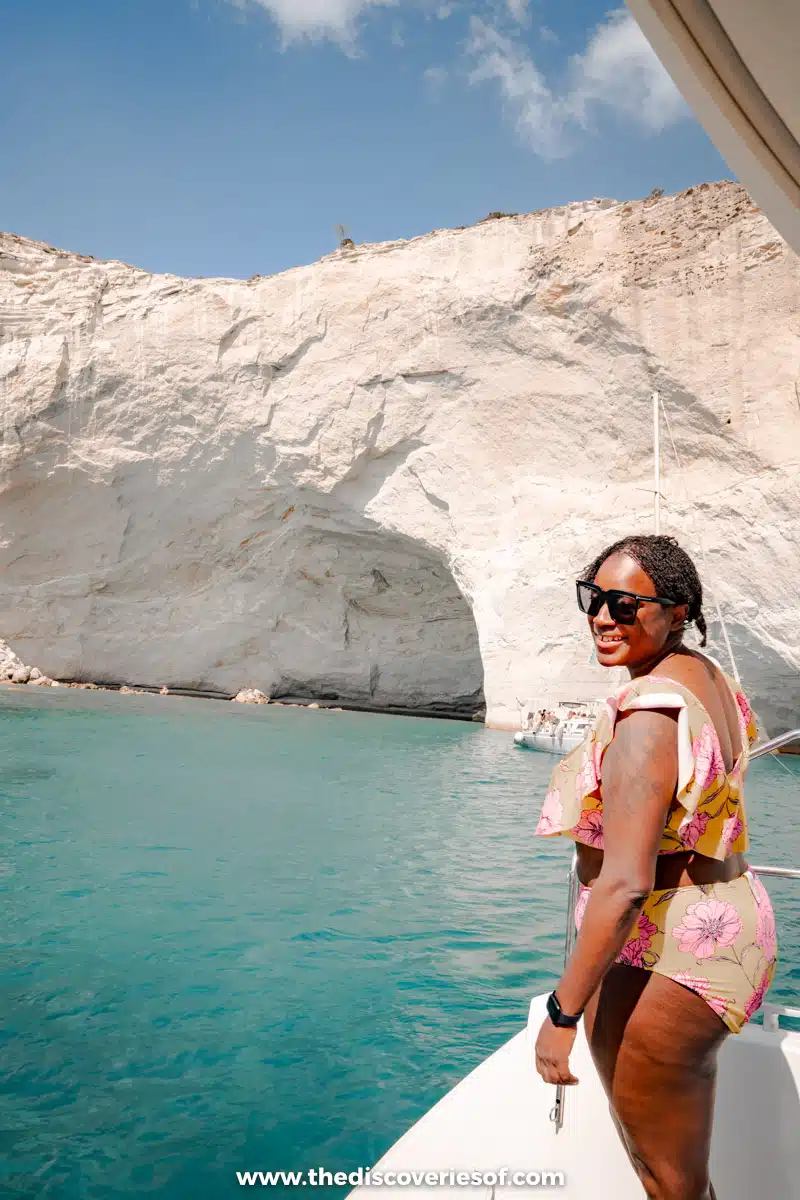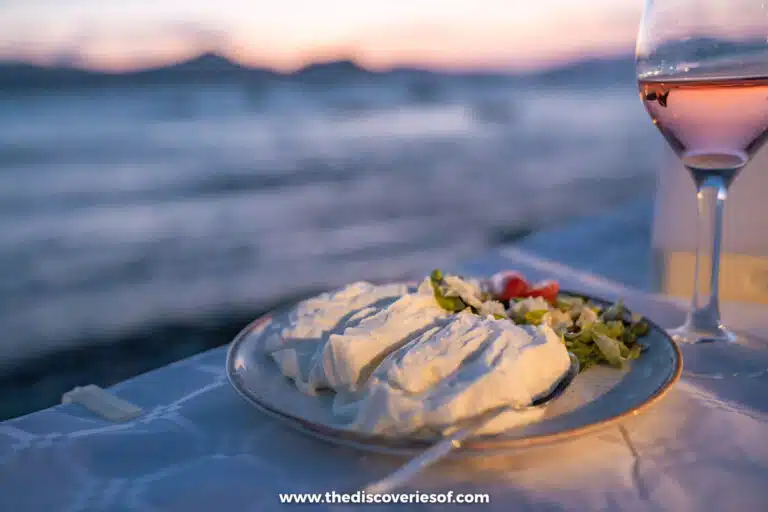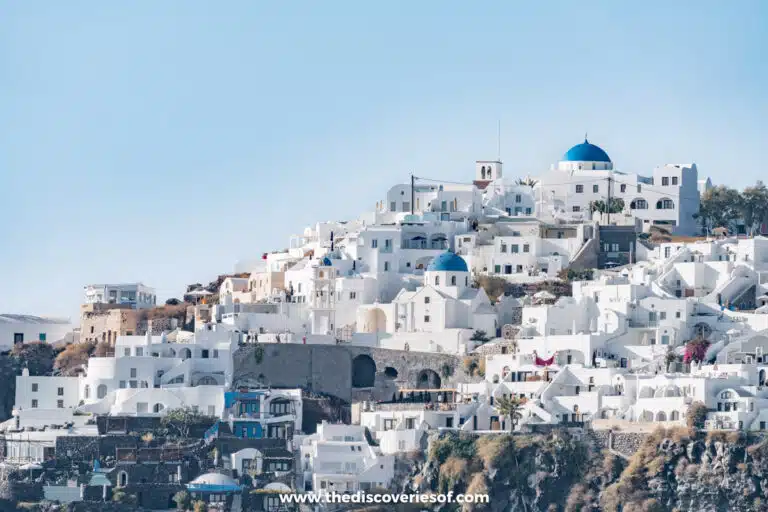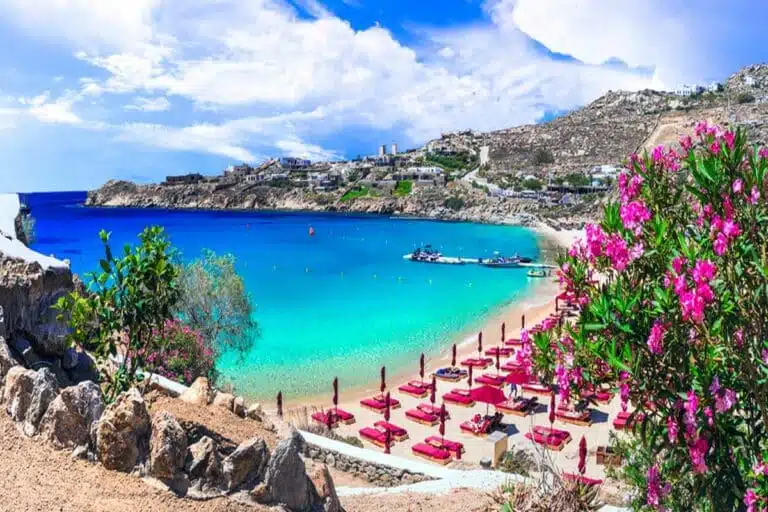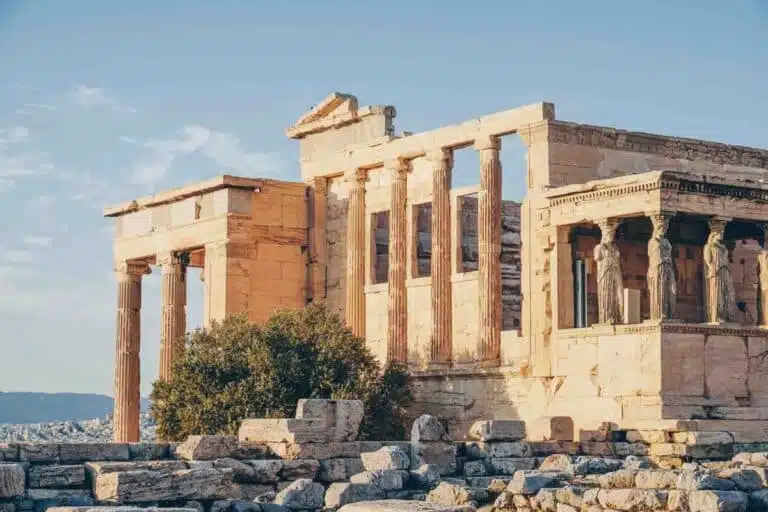Ready to explore the best things to do in Milos? Discover geological marvels, colourful villages, and one-of-a-kind beaches with this in-depth guide.
The charms of Greece’s thousands of islands are no secret, with some islands in the Cyclades (Santorini and Mykonos, I’m looking at you) feeling more and more like a stomping ground for the whole of the continent in the peak summer months.
But another island is slowly earning a reputation as an off-the-radar gem. The lesser-known Cycladic island of Milos is home to an incredible coastline with rocky volcanic shores spilling into translucent blue-green waters in nearly all of its 90 beaches.
With only 6,000 people living on the island, finding information on where to go and what to do on Milos can be a little tricky. Luckily, that’s exactly what this guide will do. I spent a few weeks on this elusive island, exploring everything from ancient ruins to far-flung beaches – not to mention with plenty of restaurants and thrilling activities in between.
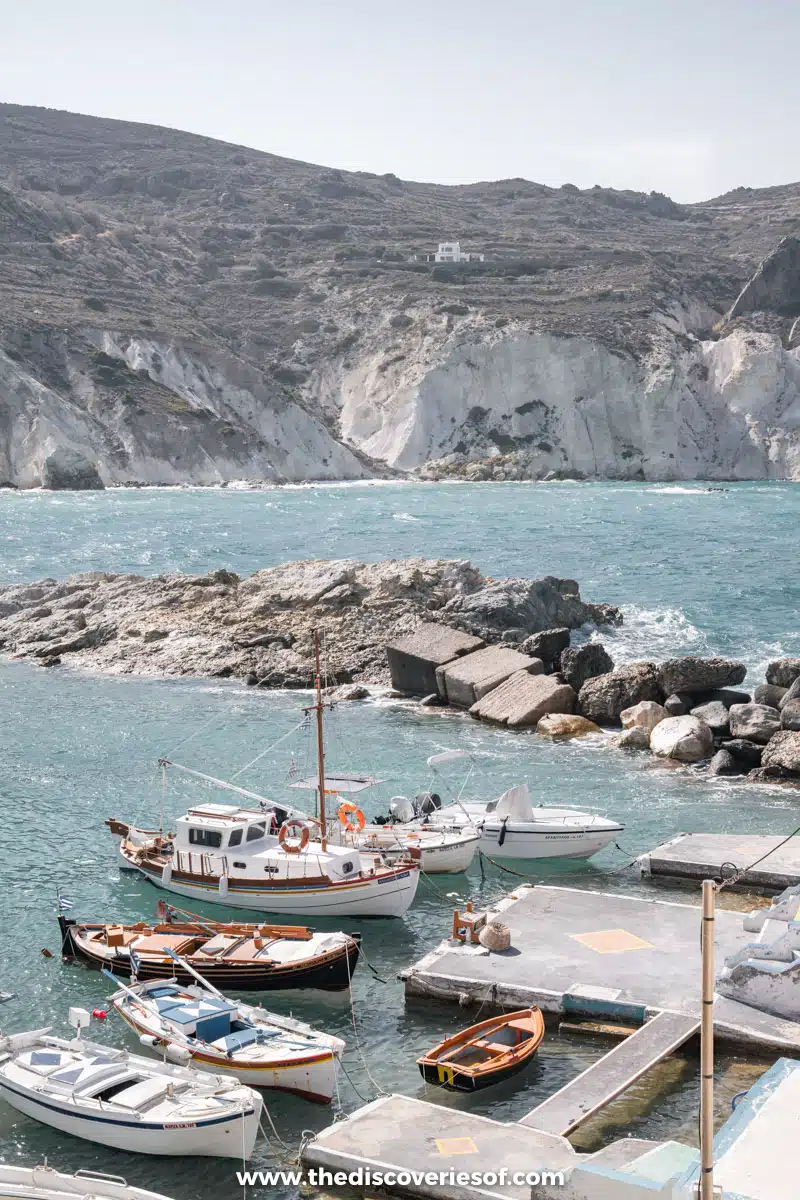
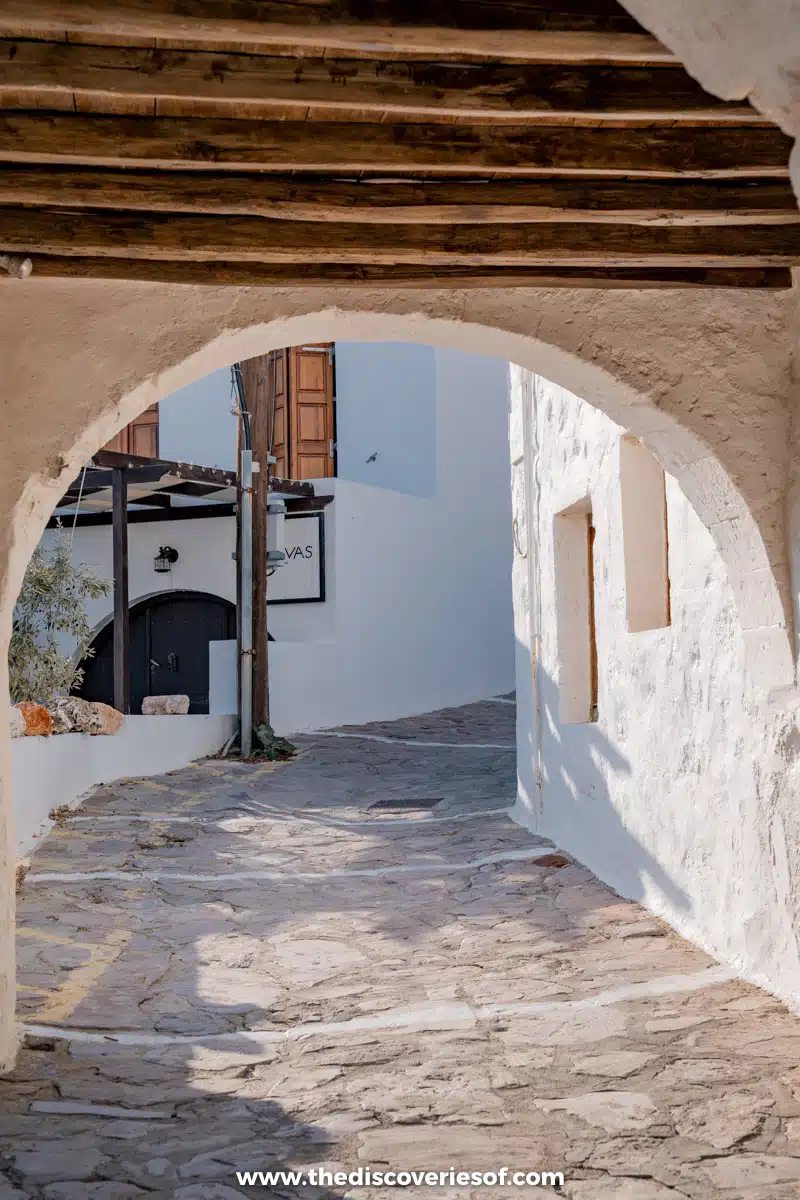
What I found was a heady mix of otherworldly landscapes like Sarakiniko (one glance is enough to see where it gets its nickname “Moon Beach” from), to less familiar historical treasures like the Roman ruins at the Ancient Theater of Milos – all complemented by a food scene that is *chef’s kiss*.
Ready to explore the island’s treasures? Let’s go.
PS: Take a peek at my top recommendations on my YouTube video.
Best Things to Do in Milos
Chill at a Hidden Cove in Kleftiko
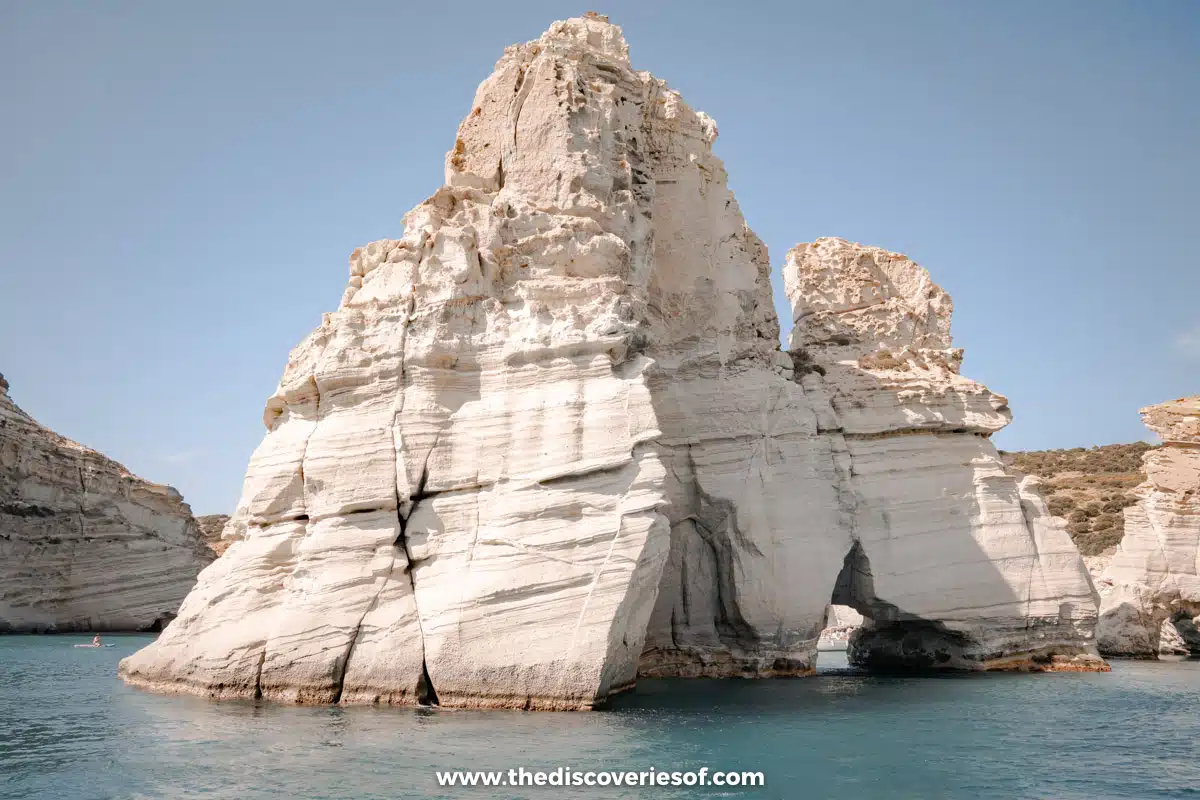
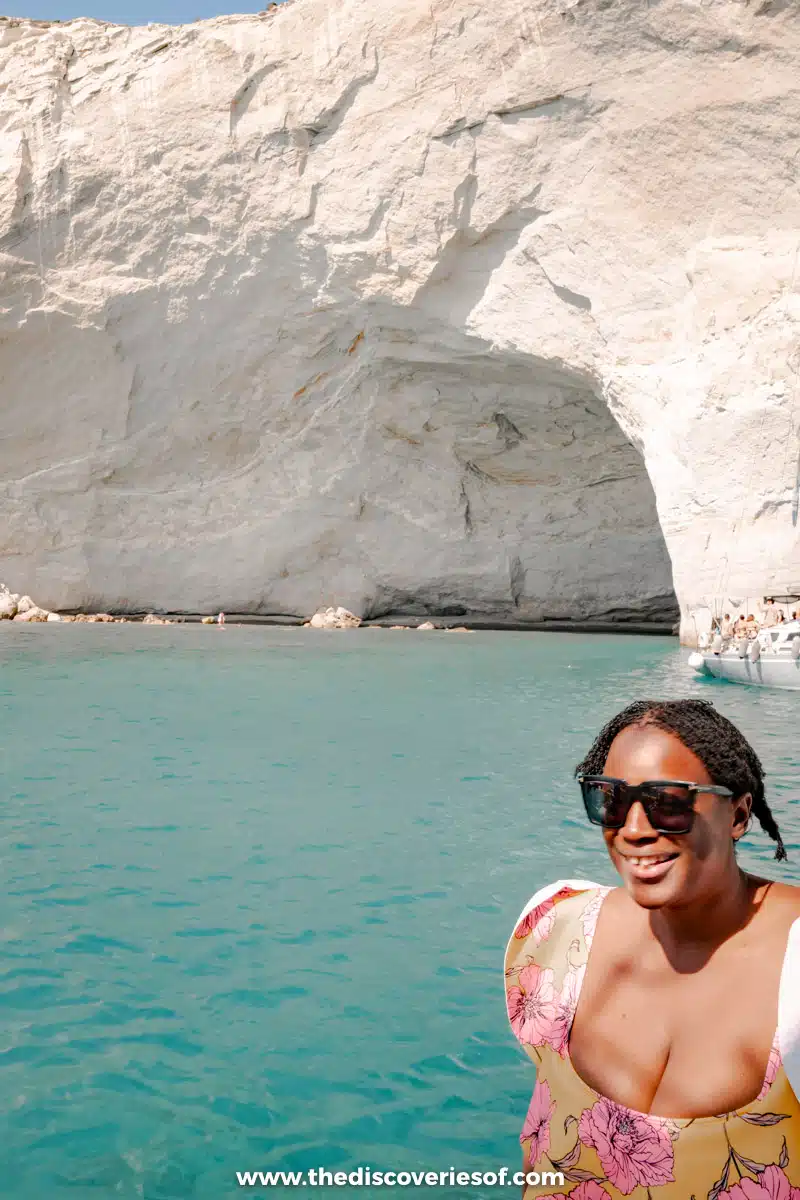
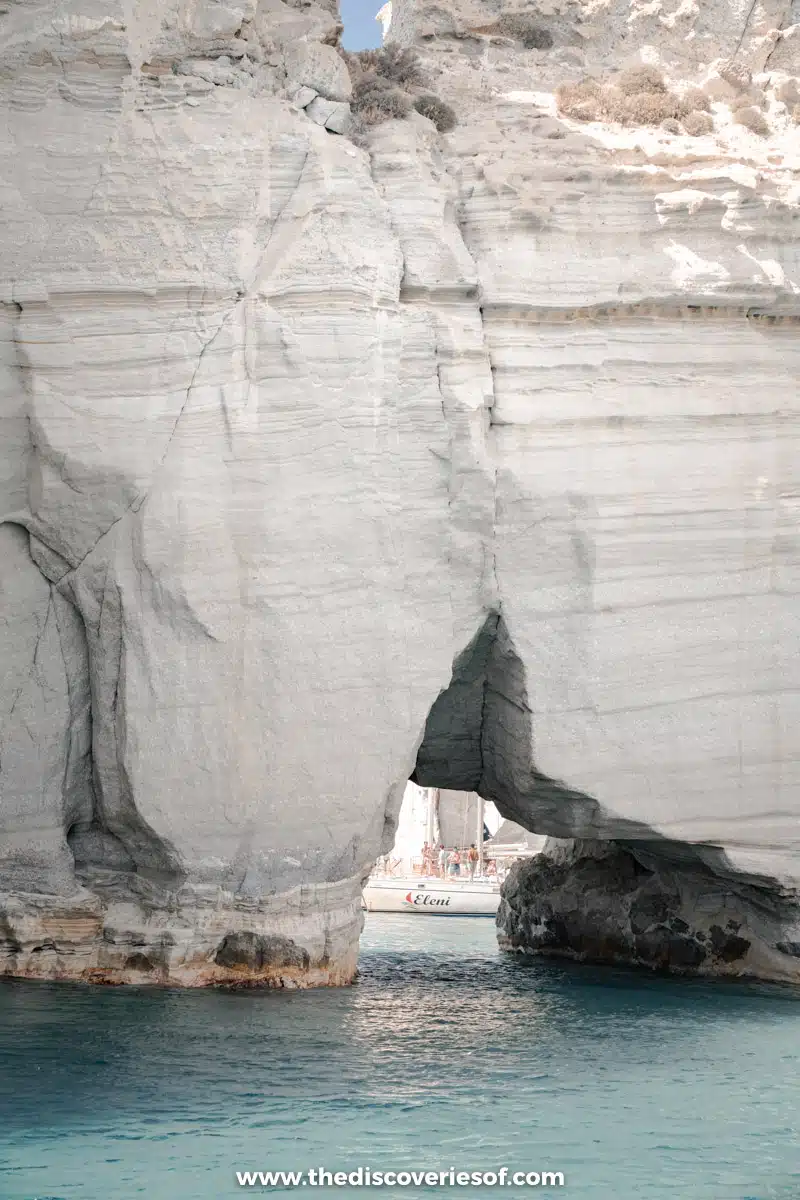
Keen to explore a “beach” that you can only approach by boat? I thought so. Venture to Kleftiko, where you can see a stunning series of white cliffs etched in voluptuous shapes that jut into an impossibly blue sea below.
It’s not a surprise that this used to be a pirate lair. The way the stark volcanic rocks encircle the pristine bay lends itself to a natural hideout as much now as it did then.
So how do you get there? You can only reach Kleftiko by water, but you owe it to yourself to do so. Spend some time swimming in the series of arches and small pools and see why it’s one of the most famous spots on the island.
It’s more popular than it used to be, but if you get a great captain (like I had), you can tuck into a quieter cove and have the area all to yourself.
Flop and Drop on Milos’ Stunning Beaches
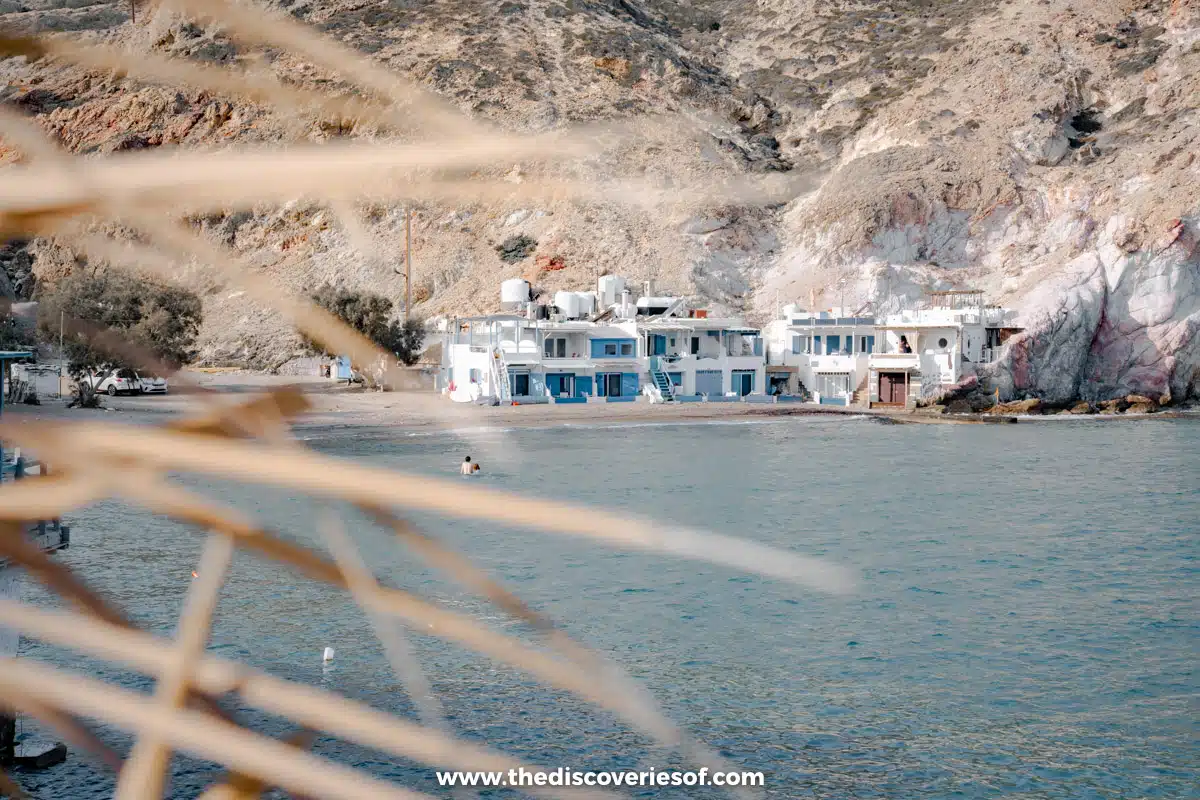
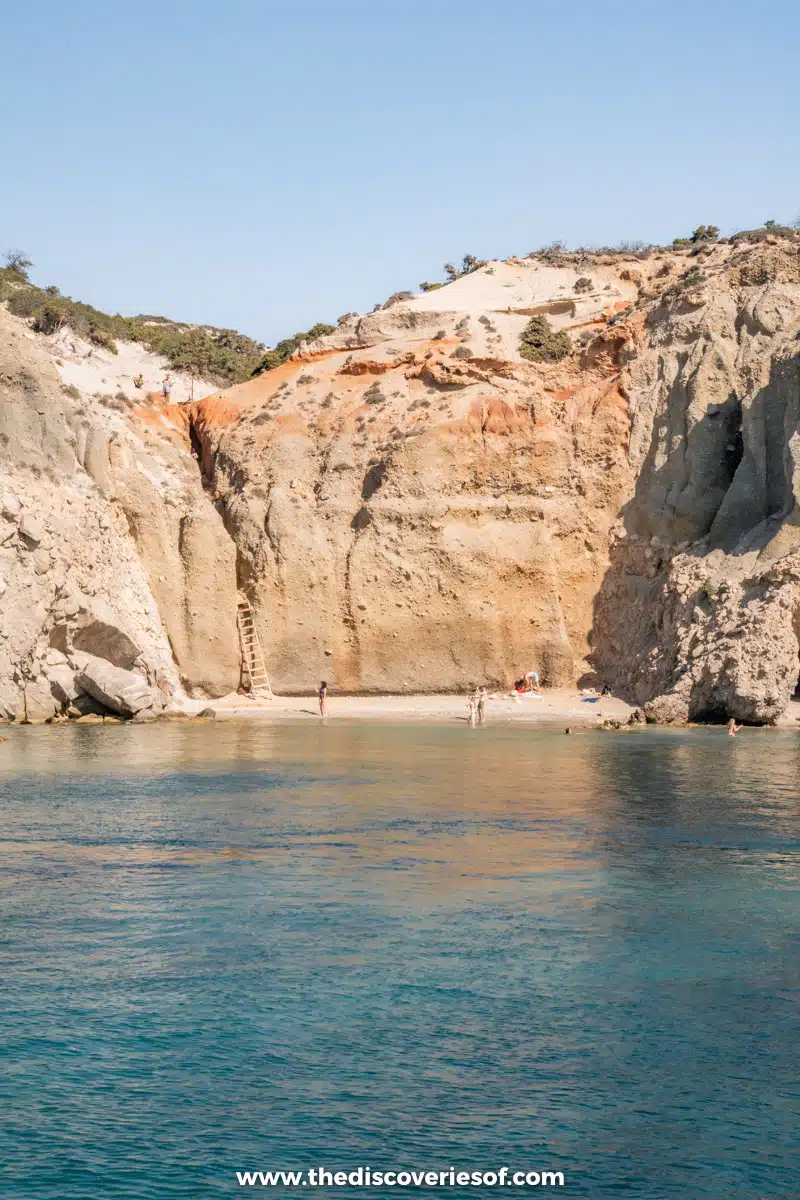
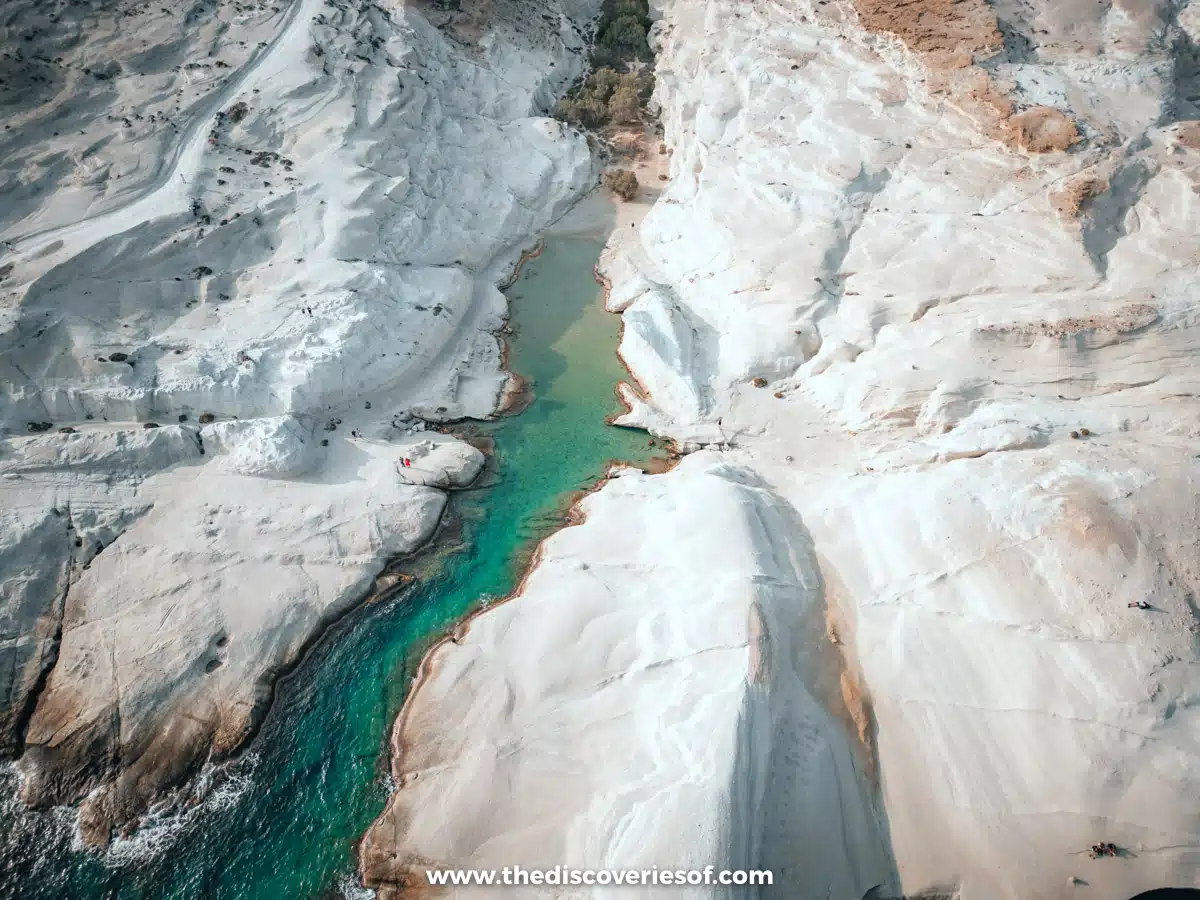
There are more than 90 beaches on Milos. Naturally, I hit a few dozen on my last visit, so I can tell you that these aren’t just any beaches. The island’s unique geography and geology culminates in white volcanic soil that lines the rocky shores contrasted with bright blue waters to produce some of the most scenic coastal landscapes anywhere in Europe.
Flop down on brilliant sandy beaches like Firiplaka Beach (one of the most popular locations on the island), where you can stare from a cool little beach bar at the brilliant, crystal-clear waters that look like they’re straight off a postcard.
And then there are the hidden beaches that take a bit more effort. Choose the latter, and you can putter along the coastline to Agia Kiriaki Beach – another fabulous swimming beach with cerulean waters and the bonus of shade from trees.
Or, pack water and snacks and use a series of ropes and ladders to get to the mysterious Tsigrado. The small sandy cove is completely surrounded by volcanic rock that’s slowly crumbling into the sea. Paliorema Beach is even more unusual, as the beach sits below the ghostly remains of abandoned sulphur mines.
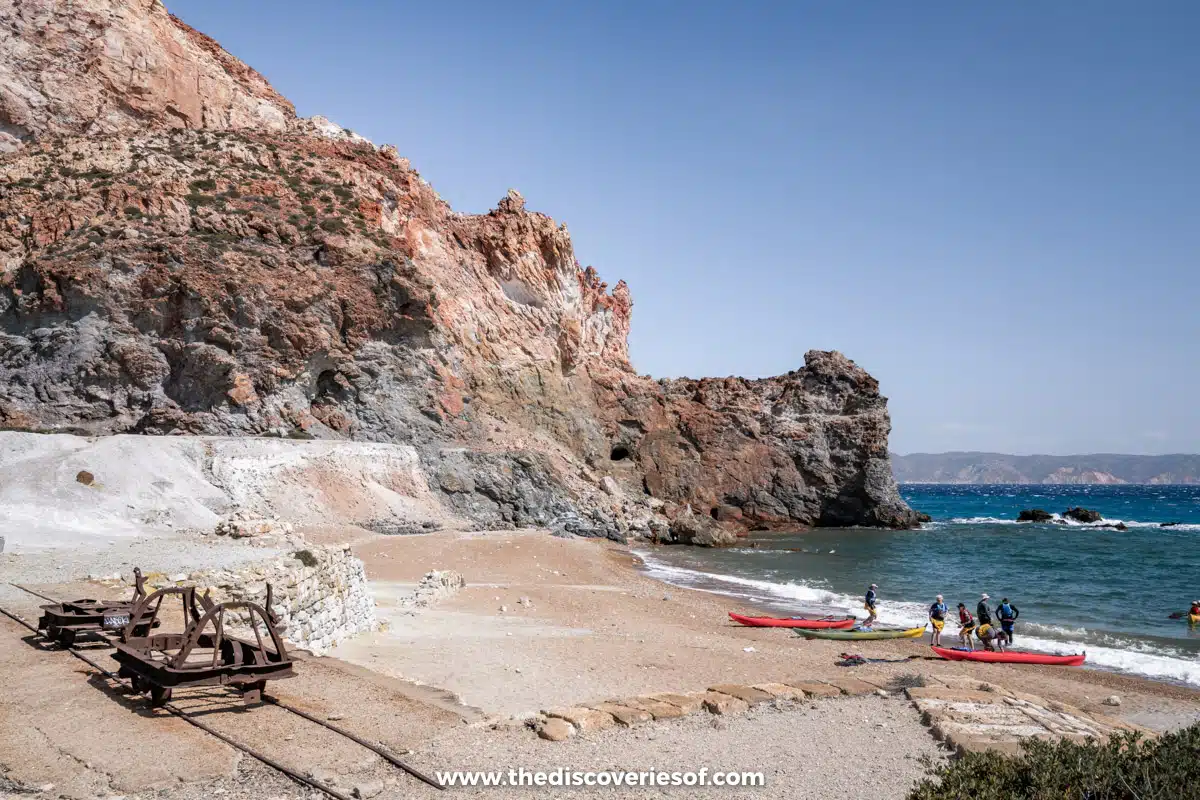
Rather scoop a spot with one of the best restaurants on the island? Paliochori Beach, with its fine rocky “sands” (perlite) and Sirocco restaurant, makes it another great area to explore.
Long story short: This is a trip where you won’t want to forget your swimsuit at home.
Take a Boat Trip Around the Island
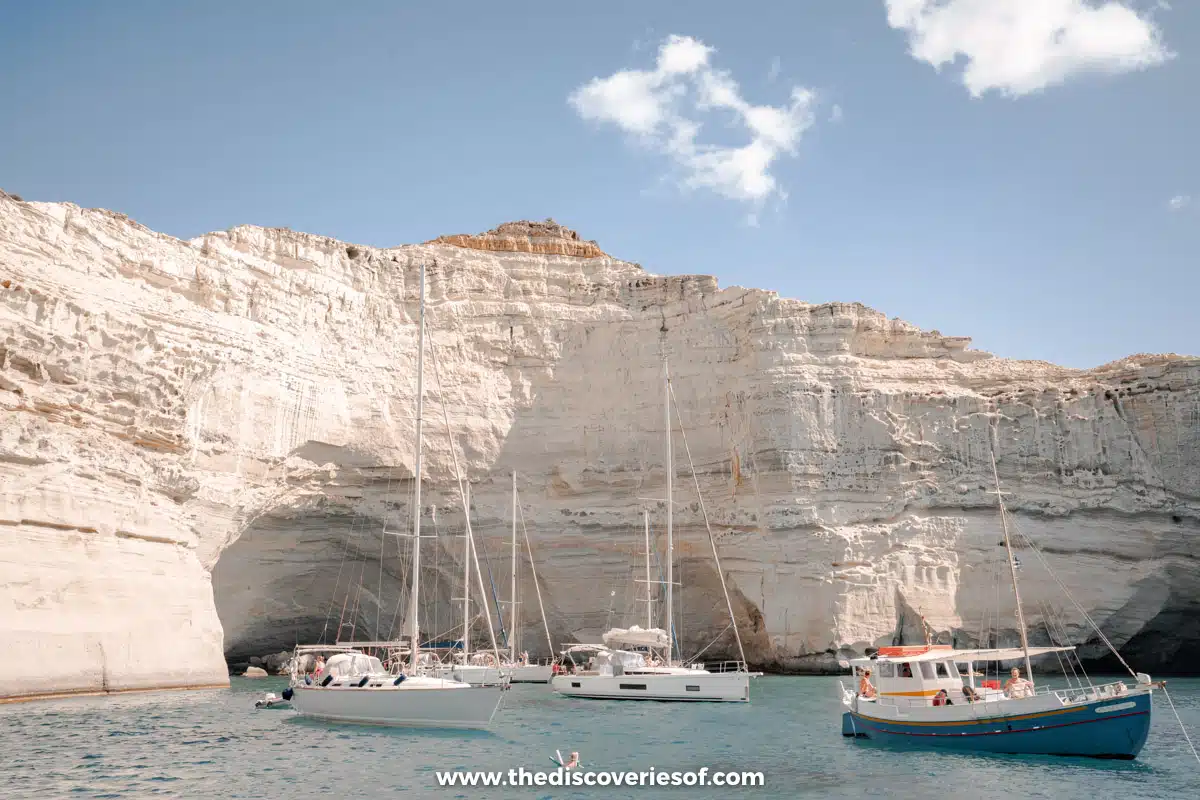
You already know that if you’re visiting Milos, you’ll spend lots of time in and around the water. So, it’s no surprise that one of my top experiences in Milos was taking a boat trip around the island. This day cruise offers an all-day excursion, which you can embark on any day of the week (weather permitting).
What can you expect? You’ll zip along the impressive coastline, admiring bizarre rock formations and pristine beaches you won’t be able to find in a car. I had a wonderful time on this smaller group tour (many travellers I talked to were added to boats with 25+ people).
A group of 10 of us set out with the brother-sister team, who honestly took excellent care of us the entire day. Best part? They even served up some hearty Greek cuisine, which was much appreciated after-hours swimming and snorkelling.
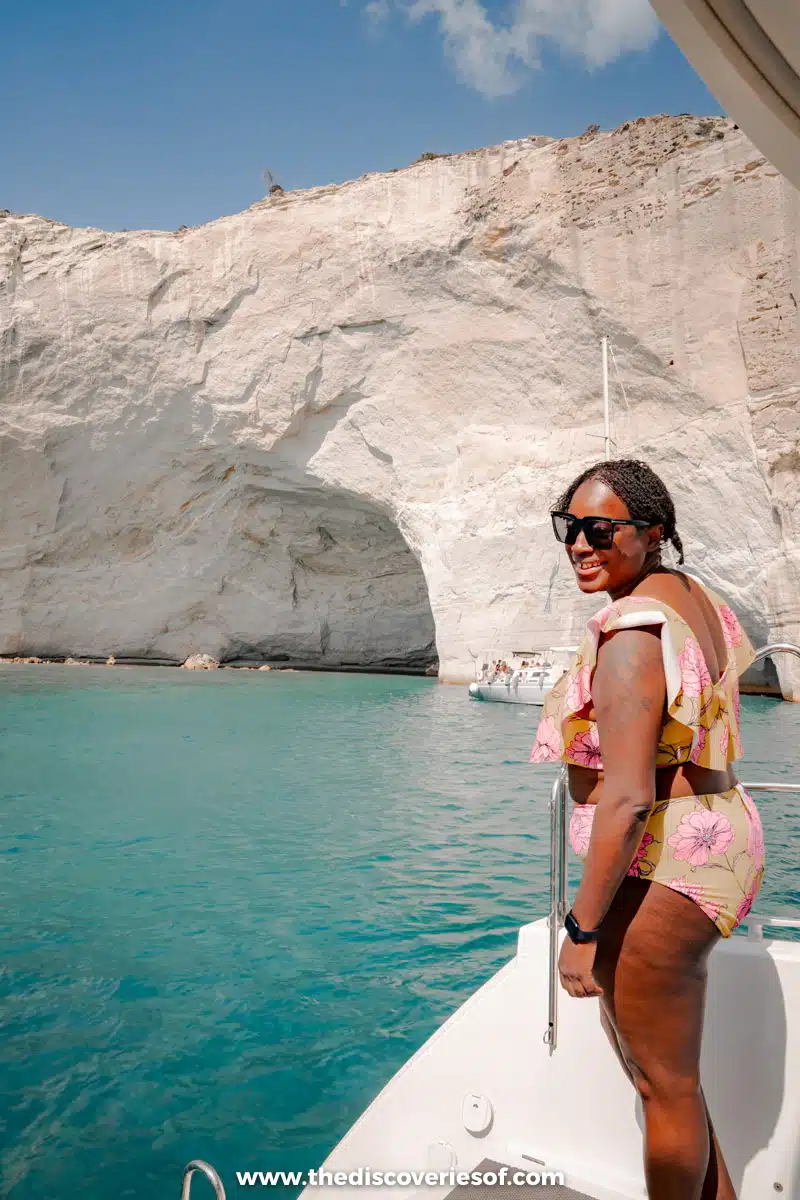
They typically leave from Adamas, but we embarked from Paliochori Beach due to the windy weather. It all worked out. We got to explore the famous Kleftiko Beach and its blue waters and white cliffs and spent the perfect day splashing in the sun.
But the coolest part was snorkelling in the Sykia sea cave, where you can peer through a massive opening (where a cave collapsed).
Explore Milos’ Culinary Scene
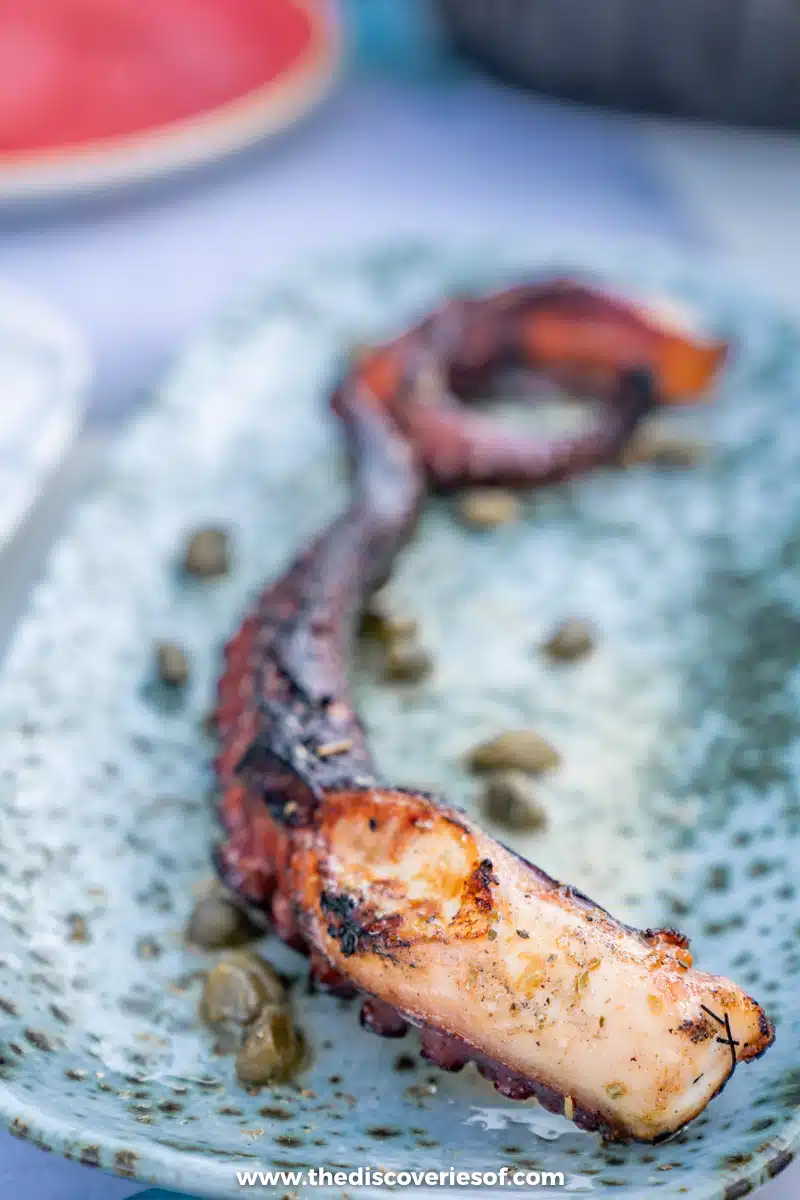
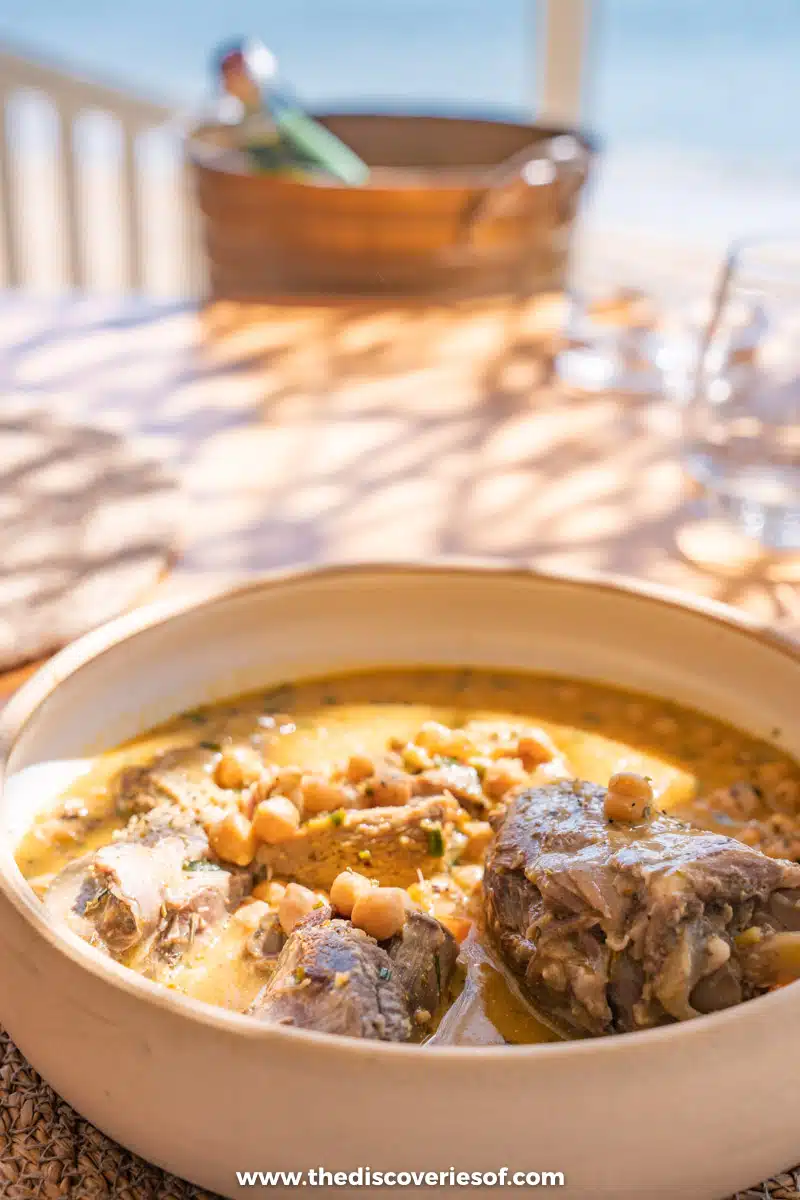
There’s no question that it’s all about the beaches in Milos. But there’s also a fantastic culinary scene you don’t want to sleep on when you visit the island.
Unsurprisingly, you’ll find incredible seafood all across Milos. Make the most of that, settling into long, lazy meals at some of the best restaurants on the island. Medusa is a charming restaurant right by a cove in the small village of Mandrakia serving traditional Greek seafood, Milos style. Tuck into dishes such as calamari and octopus against a backdrop of sparkling water.
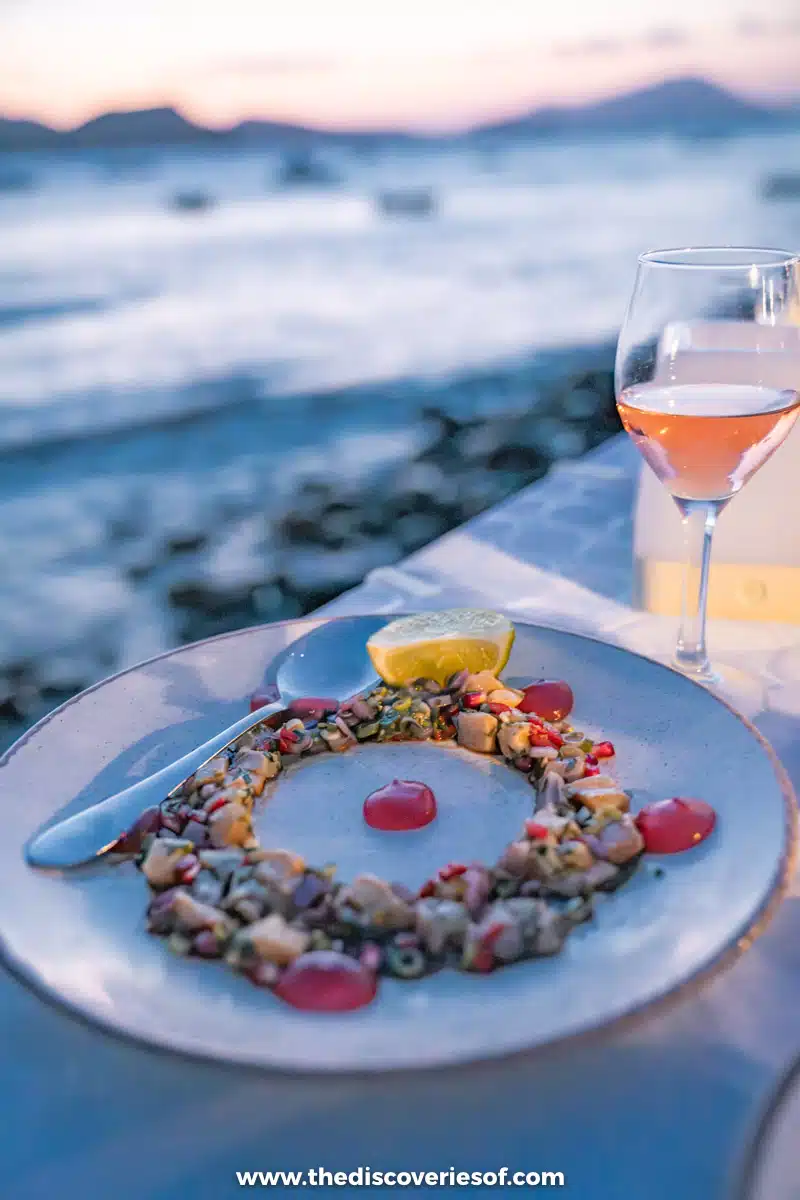
The freshly caught octopus at Astakas – with its stunning views of the coast, and the grilled sardines at seafood specialist Yialos Restaurant in Pollonia, should also be high on your list.
There’s more to Milos’ culinary scene than seafood alone – know where to look and you’ll find excellent dishes bursting with fresh veggies and slow-cooked meats (special mention goes to the baked lamb at O! Hamos! Tavern).
From the laid-back Avli in Plaka (Avli means backyard), a local favourite that’s revered for its uncomplicated (if fantastic) traditional dishes like feta pie, to the best ice cream in all of Greece at Aggeliki (yeah, I went there) – Milos is a dream for foodies.
Stroll Around Milos’ Capital, Plaka
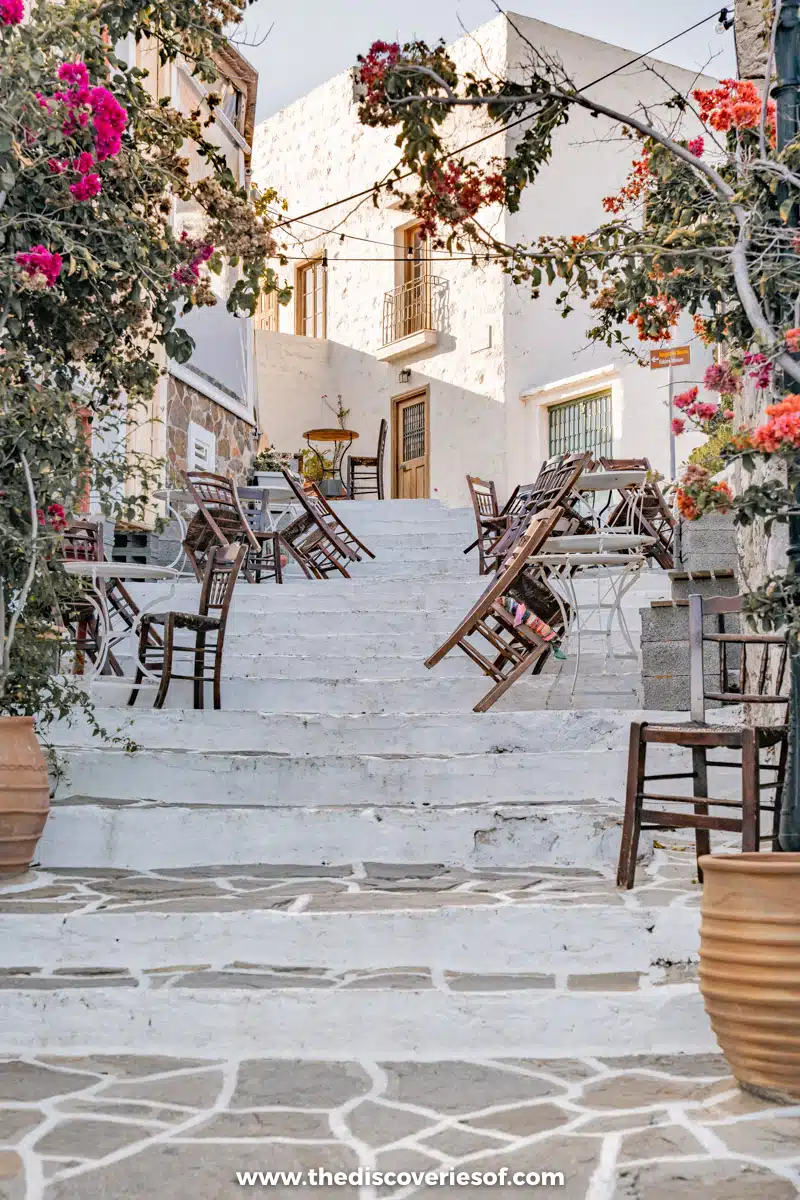
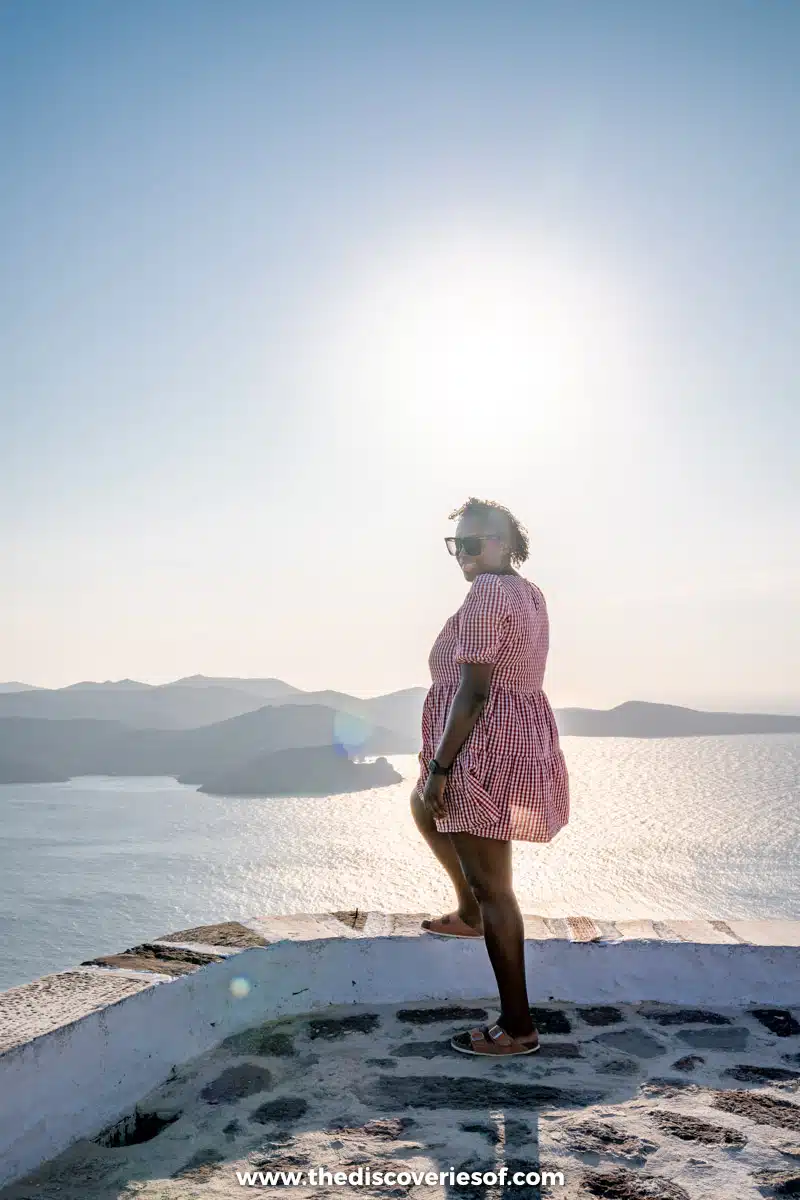
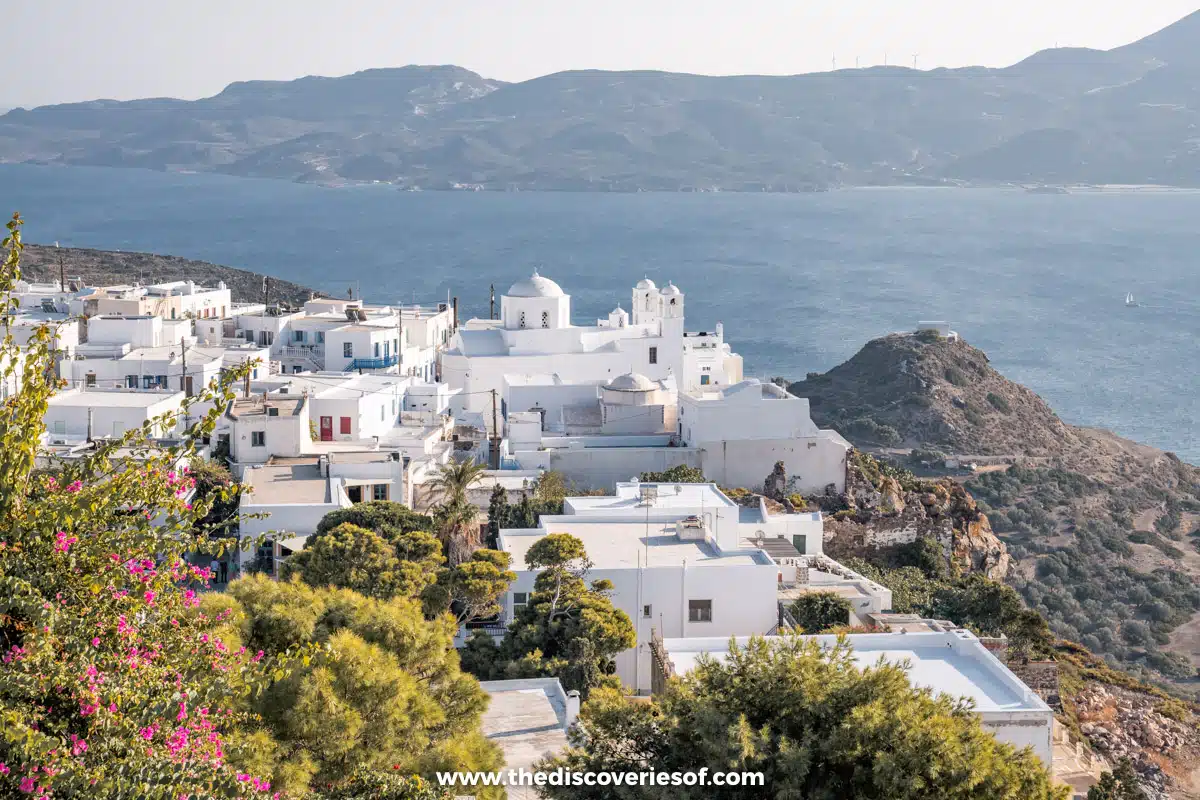
Plaka, the charming capital (or Chora) of Milos, sits atop a rock overlooking a vast swathe of sea.
It’s the archetypal picture-perfect Cycladic town: flowers and vines climb up the walls along the narrow alleyways and meandering stairways. Slow down and take a look – there are surprises around each corner.
Plaka’s history dates back hundreds of years, but the majority of the cobbled streets and whitewashed buildings you see today are from the 19th century.
While much of the town’s charm is just wandering around its quiet paths and alleys, there are a couple of things I recommend making time for.
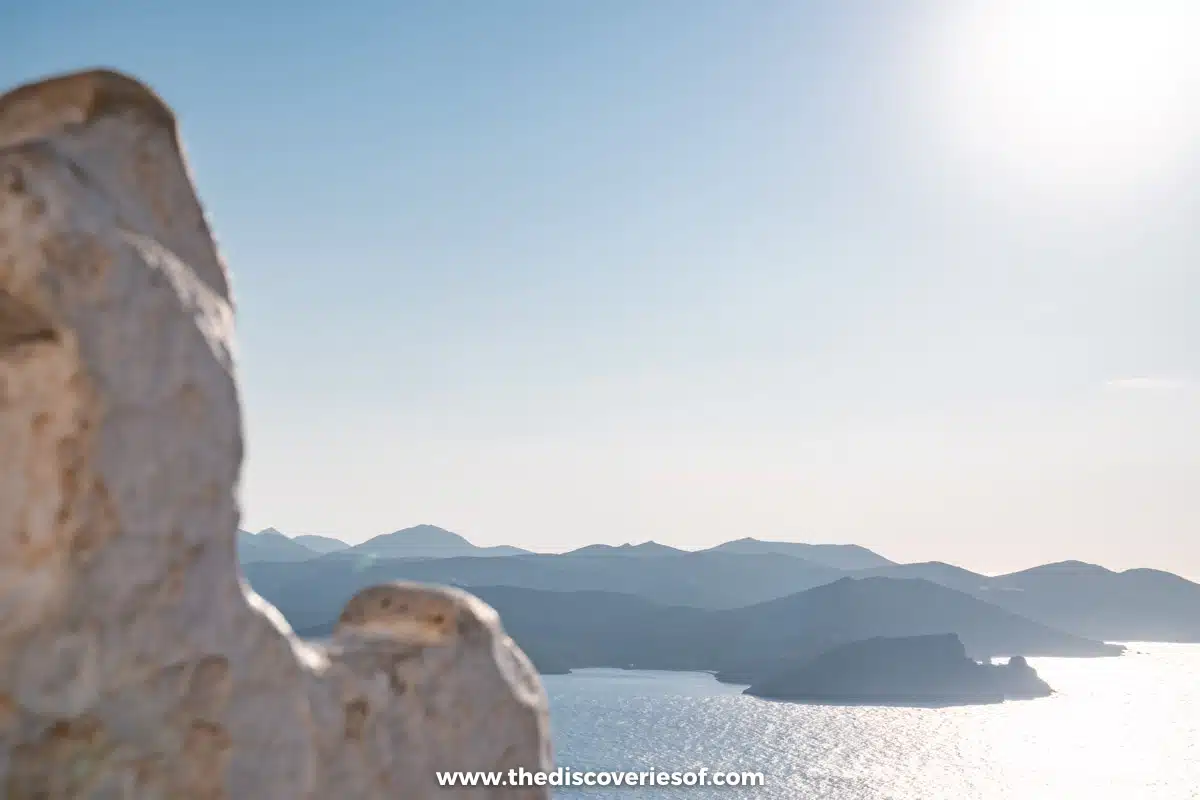
Perched on Plaka’s highest point, the Venetian Castle is worth the short but sweaty hike it takes to get there. Only a fraction of the castle (namely the old walls) remains, but its location next to a gorgeous white-domed church and the fact that it offers some of the best views on the island are reason enough to sweat your way to the top.
You can also pop into the rather quirky Sand Museum, where you can browse through a collection of sand the owner has gathered up from places all over the world. He also sells artwork, so feel free to take home a souvenir.
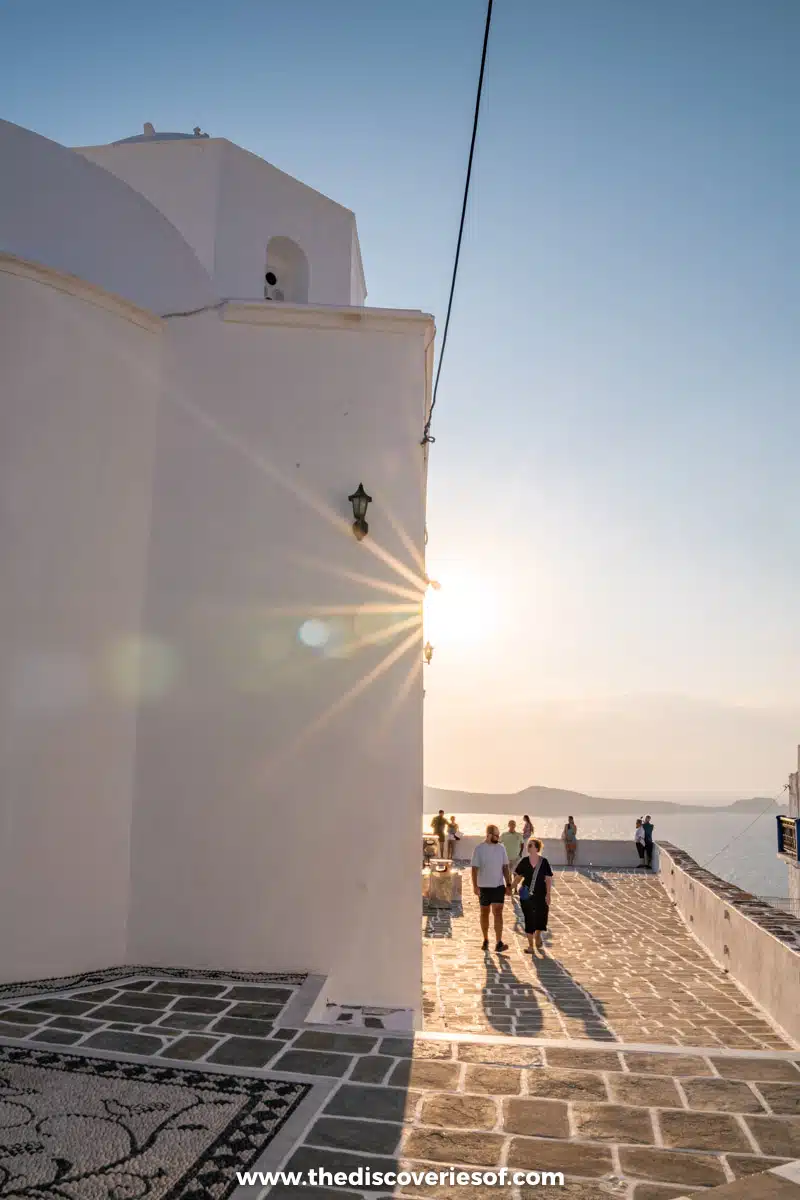
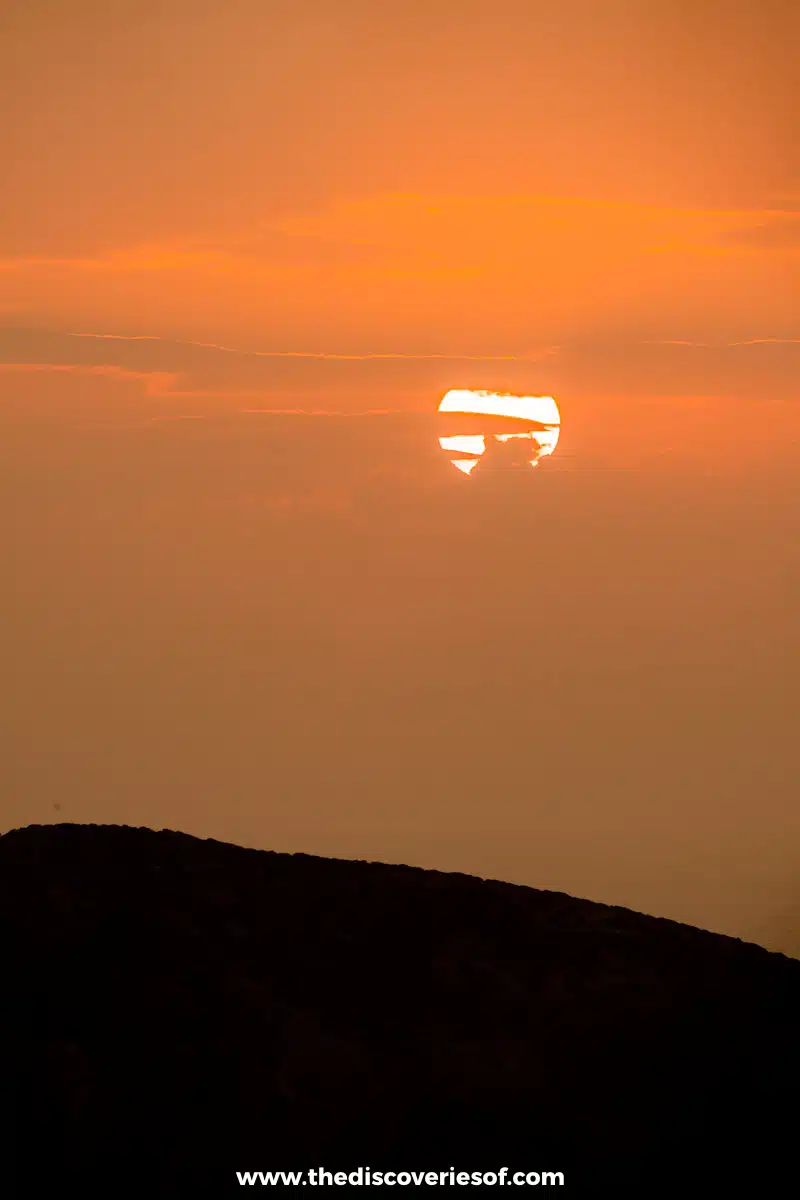
I should mention that the sunset views in Plaka rival anywhere in Santorini. In fact, I think they are better and without *quite* the same level of crowds – go to Utopia for cocktails and the very best views or grab a cocktail at Verina and walk the short distance to sit on the church walls to watch the sun dip below the horizon.
Top Tip
You can’t drive into Plaka, so you need to leave your cars at the car park at the bottom of the town and walk in. There are several free parking lots, but avoid the ones in the north as they’re only for residents.
Cliff Jump and See the Lunar Landscapes at Sarakiniko Beach
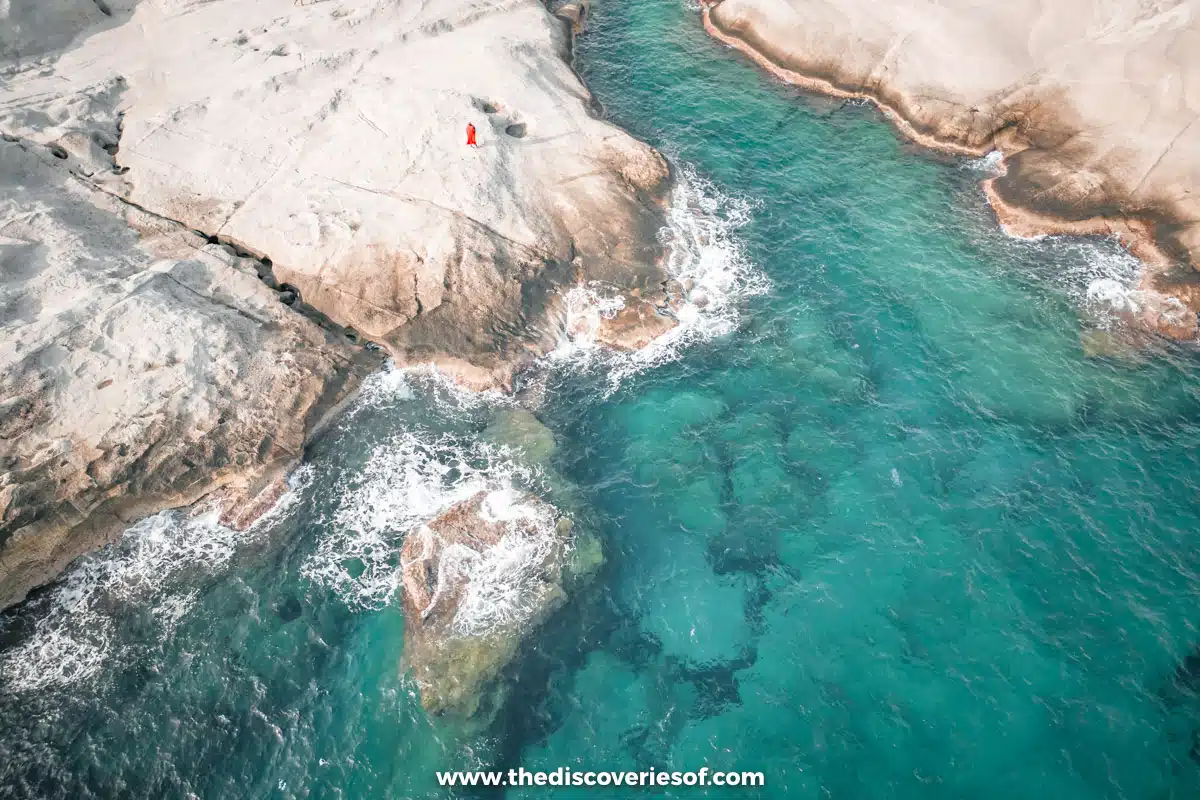
I’m not one for issuing mandates, but you have to go to Sarakiniko Beach during your Milos trip.
Moon Beach (as it’s nicknamed) features sweeping boulders as famous for their extraterrestrial appearance as they are for being epic cliff-jumping platforms. To say the rocky shores are nearly blinding with the sun hitting the bright white surface isn’t an exaggeration.
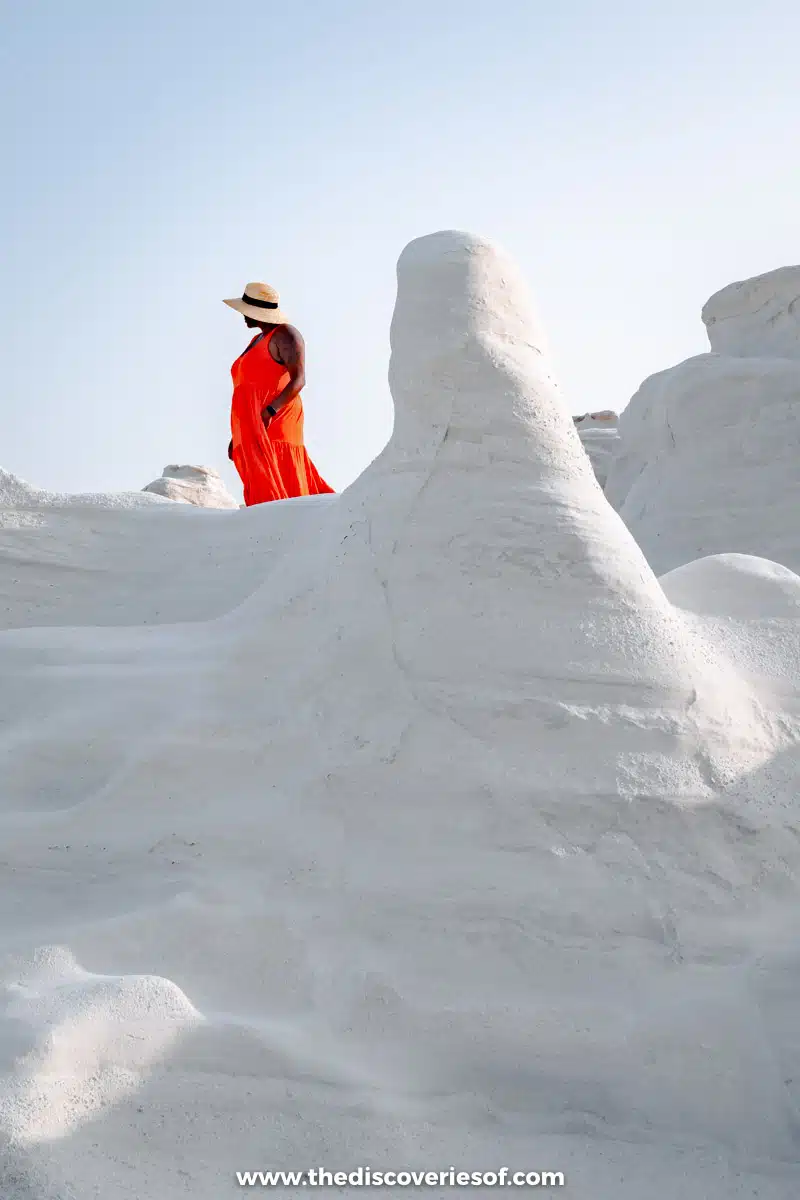
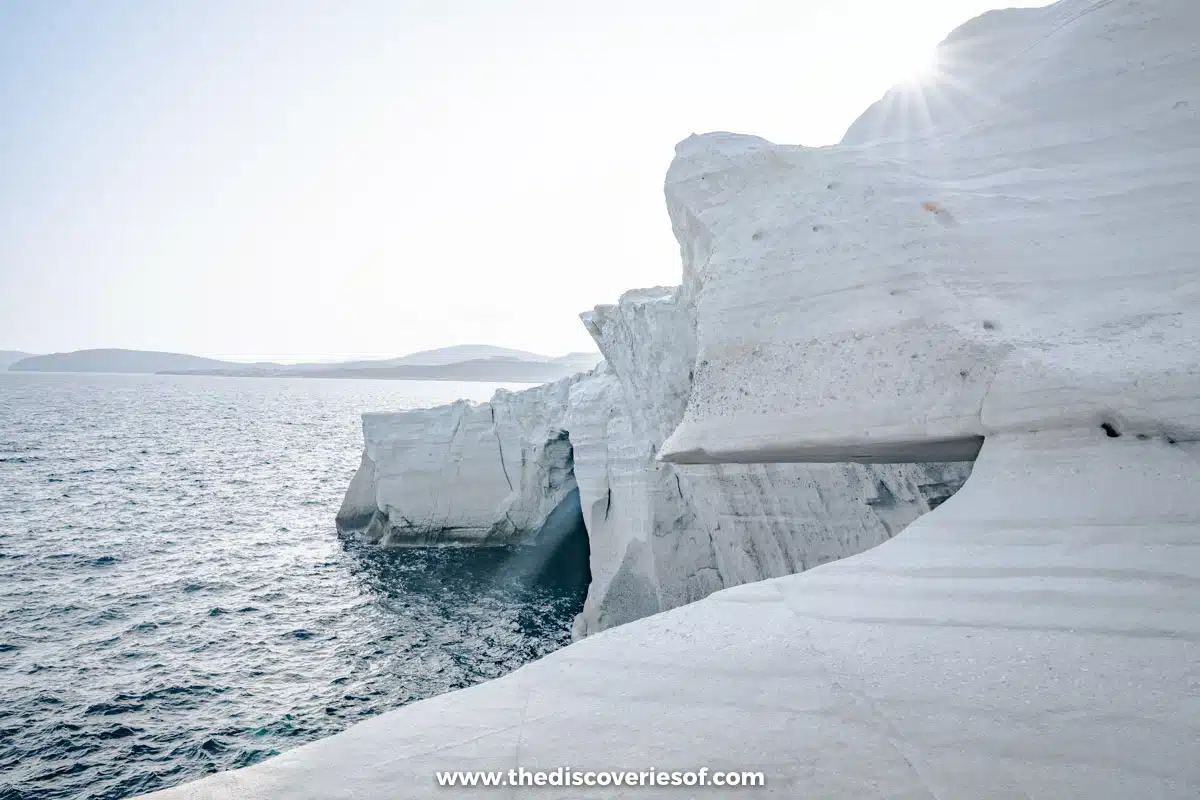
The beach isn’t the sandiest by any means (though there’s a small stretch you can wade in the water). Instead, it’s the smooth, chalk-white volcanic rocks that you can use to sunbathe or plunge into the sparkling blue waters that are the main draw.
Nearly all of the best beaches in Milos are in the South, so it’s quite striking that this unusual beach is in the North. But the secret is out, so you’ll want to pull into the parking lot as early as possible.
On my last visit, we arrived around 8:30 am, and there were already quite a few other people there. By the time we left at 10 am, the parking lot (and rocky shores) were full. Go early in the day or late in the afternoon, or prepare to deal with crowds.
Top Tip
Alternatively, Papafragas Caves is another popular cliff-jumping locale and former hideaway for Byzantine-era pirates.
Venture to Postcard-Perfect Klima
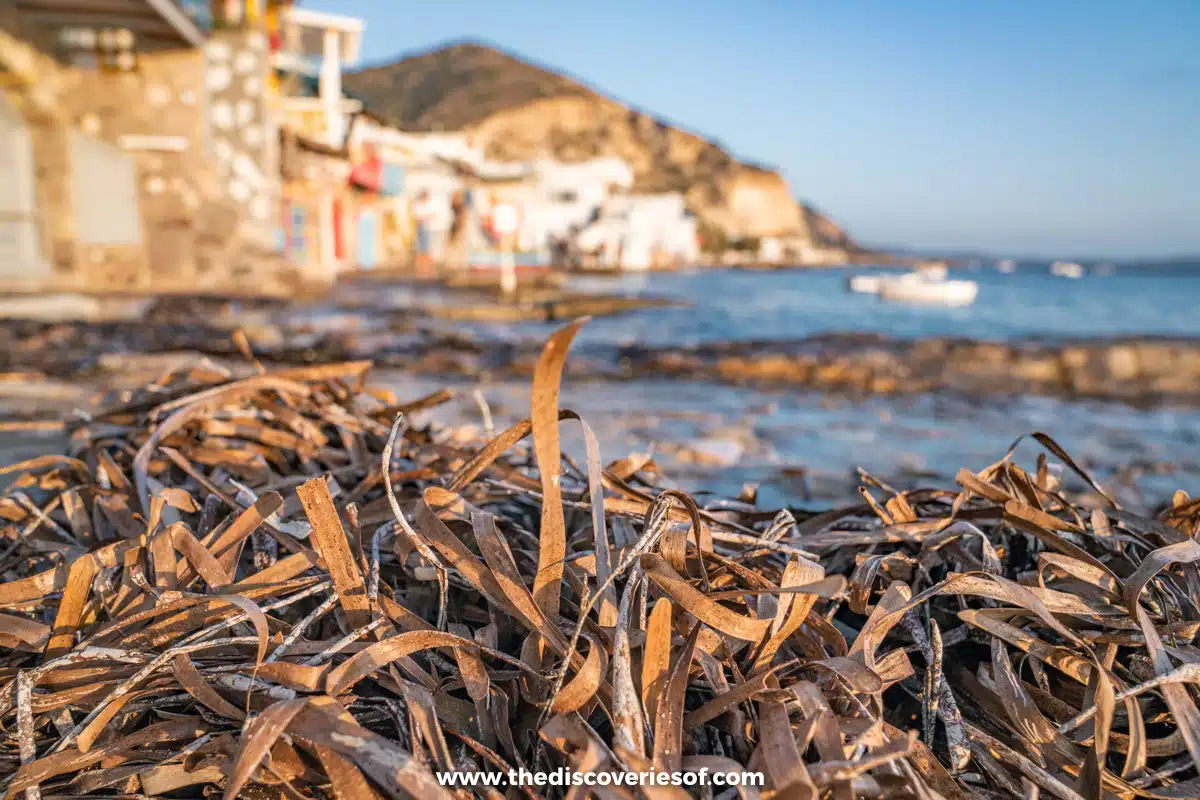
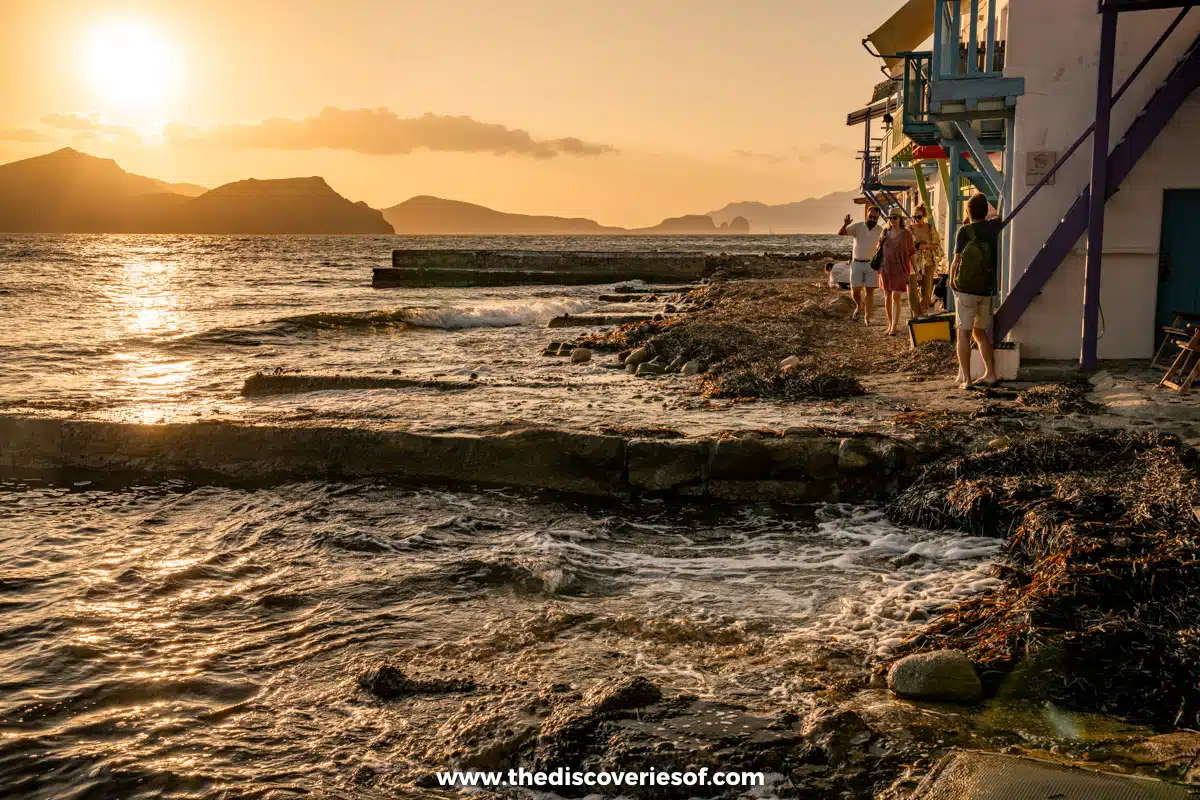
Milos has quickly earned a reputation as a stunningly scenic island with beautiful, colourful fishing villages dotting the volcanic shores.
Klima is arguably the most beautiful of these villages, with white-washed coastal homes featuring brightly coloured doors and windows on the edge of the sea. The bright and varying colours on the doors are no accident. Historically, they coordinated with the boats, so you knew which house belonged to which fisherman.
Plan to spend an hour in the early evening strolling around the village by daylight before watching it glow in the golden hues of sunset. The light on the water is absolutely magical.
Round off the day with dinner at the waterfront restaurant Astakas, one of the best restaurants on the island.
Getting There
There’s parking right behind Astakas. It’s a bit of a steepish drive down, but it’s easily doable.
See the Abandoned Sulphur Mines
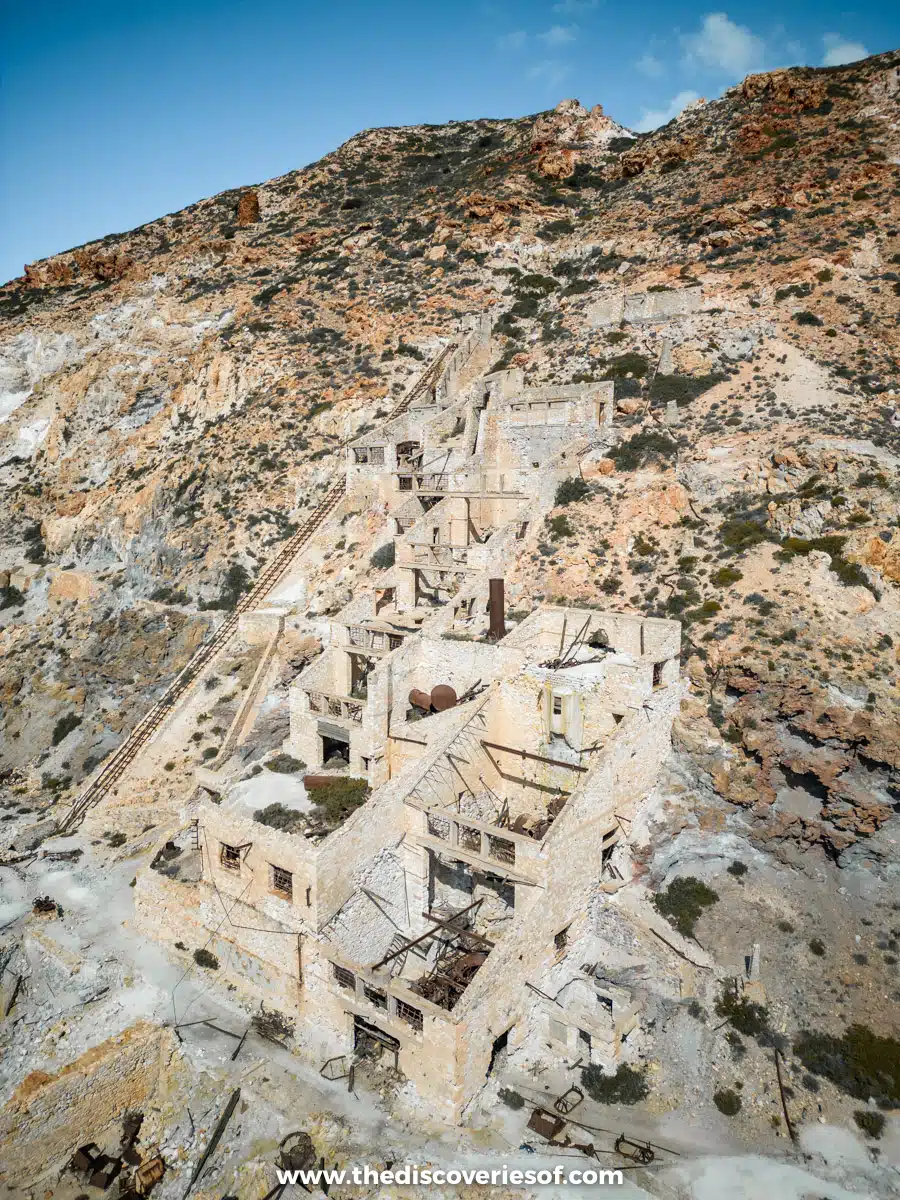
Heading down to the abandoned sulphur mines might not sound like the most charming afternoon, but trust me, exploring the rocky sands and abandoned buildings at Paliorema Beach is a treat.
Ready for an adventure? Venture to the eastern side of the island, where the eerie abandoned sulphur mines emerge from a rainbow-coloured cliff on Milo’s coast. The stark contrast between the dramatic volcanic cliffs, buildings etched into the hillsides and stone arches framing perfect views of the Aegean Sea cemented it as one of the highlights of my time on the island.
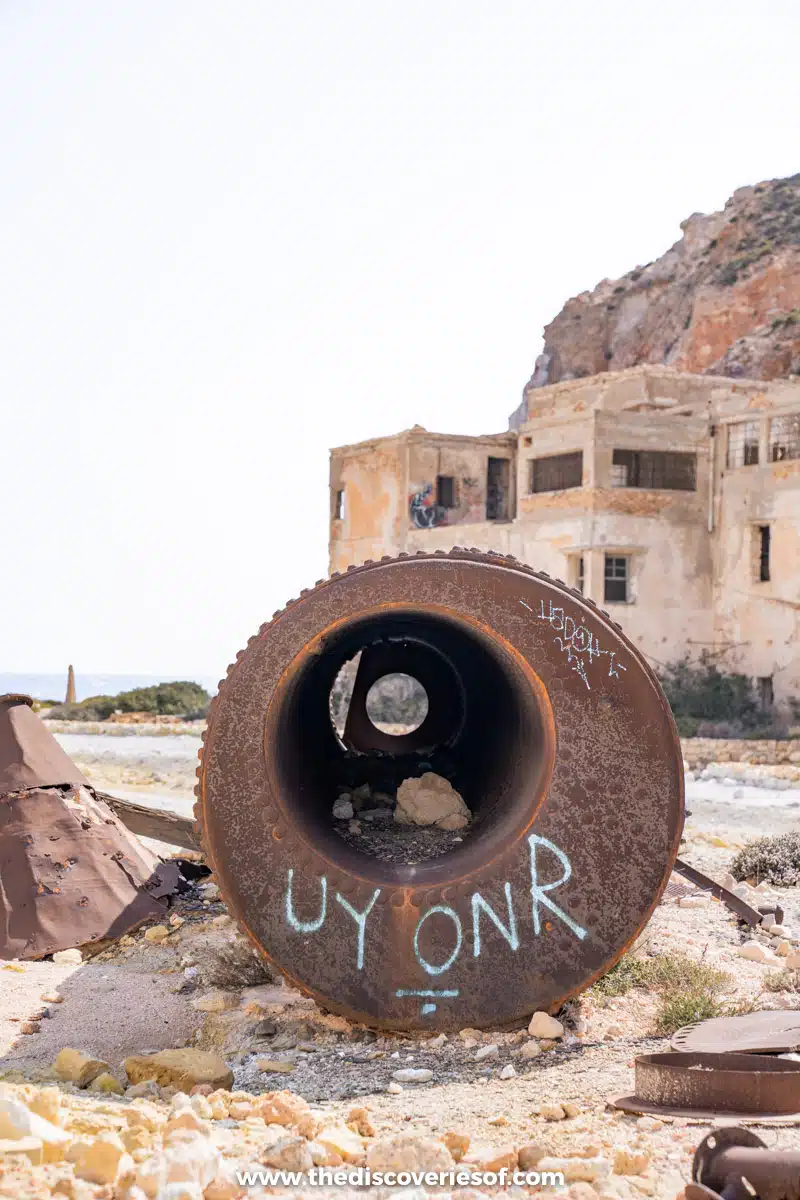
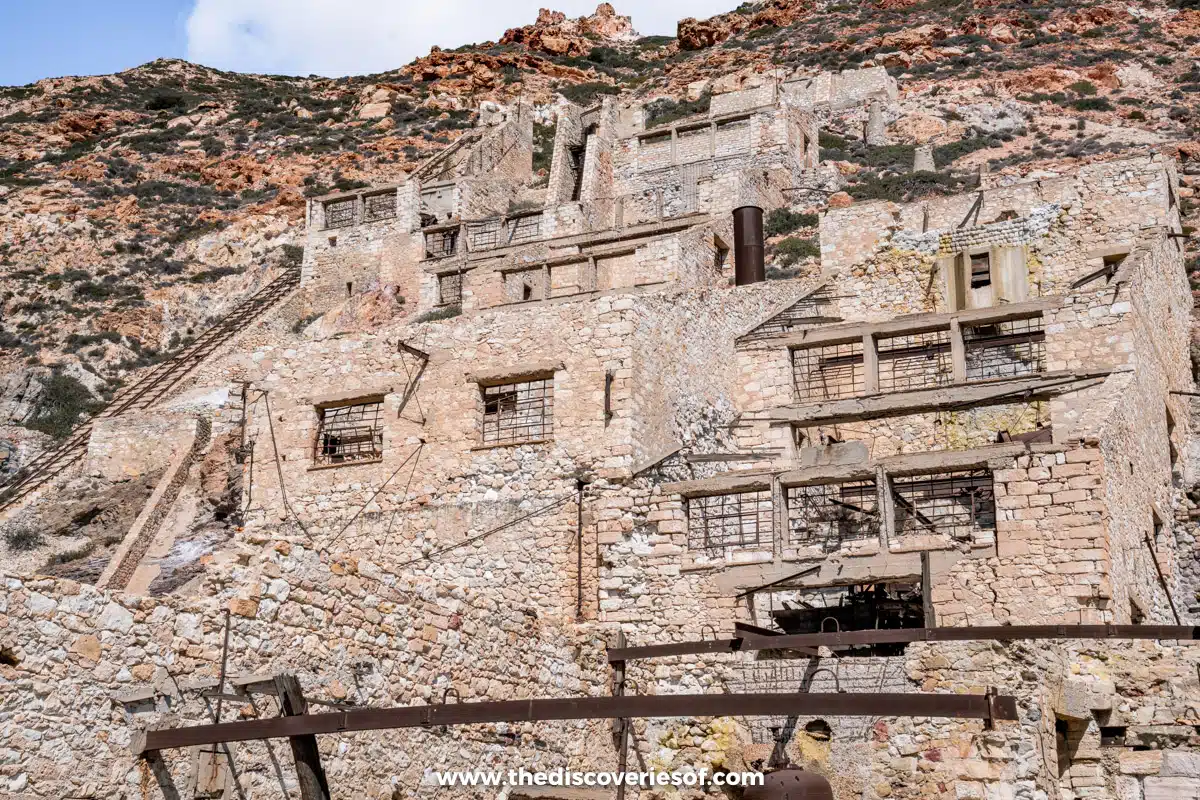
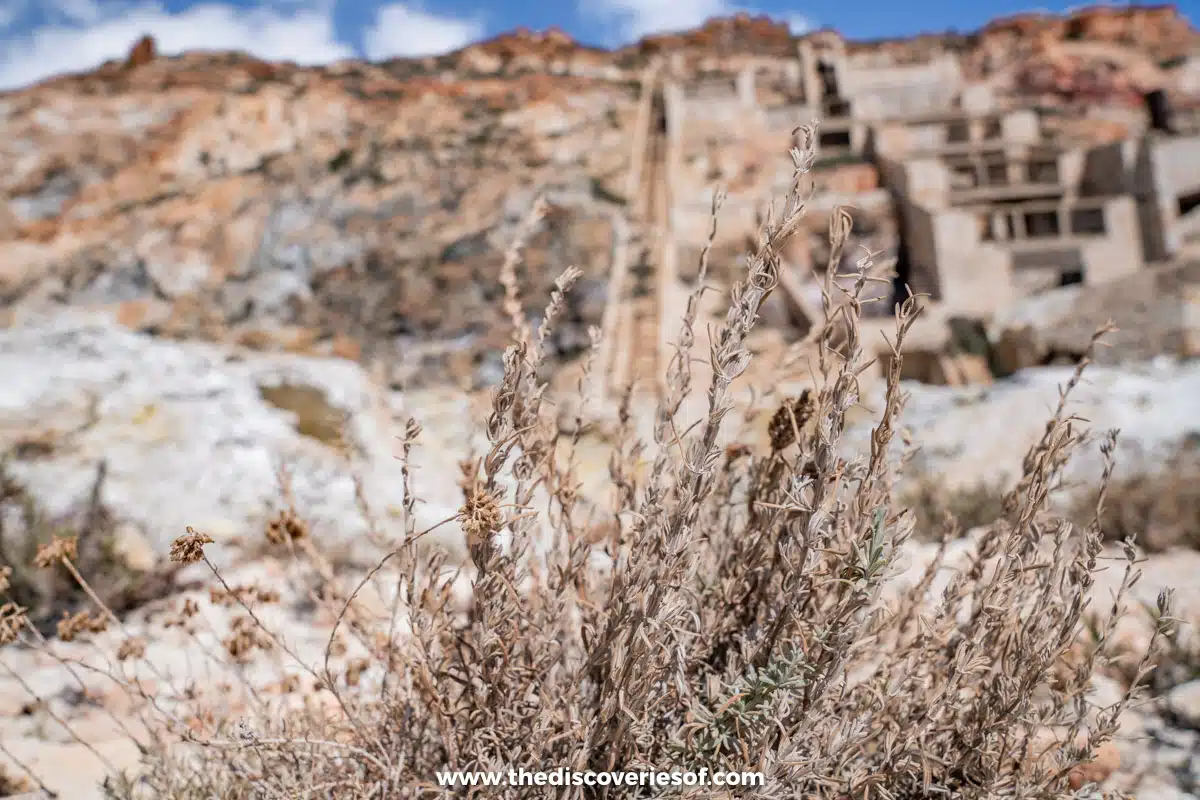
Keen to explore? It’s a cool spot to see the abandoned buildings and rusting machinery that are so at odds with the idyllic setting, it’s hard to believe it’s real. Until you realise you can still smell the sulphur.
Getting there is easy enough – before we went it wasn’t very clear from online comments how hard it would be to drive all the way to the mines, but if you’re a relatively confident driver you can drive all the way to the bottom, even in a 2-wheel drive car.
Just take it slow, particularly at the end as it does get quite bumpy. If you’re worried, there are a couple of places to park higher up, and then you can walk down (bring water).
There’s a nice small beach for a spot of relaxed sunbathing, or you can schedule a kayaking tour that stops along the edge of the cove via kayak. However you choose to go, it’s worth a visit.
Top Tip
It’s dangerous to go inside the mines or buildings themselves, as they’re highly unstable. Don’t do it.
Spend Your Evenings in Pollonia
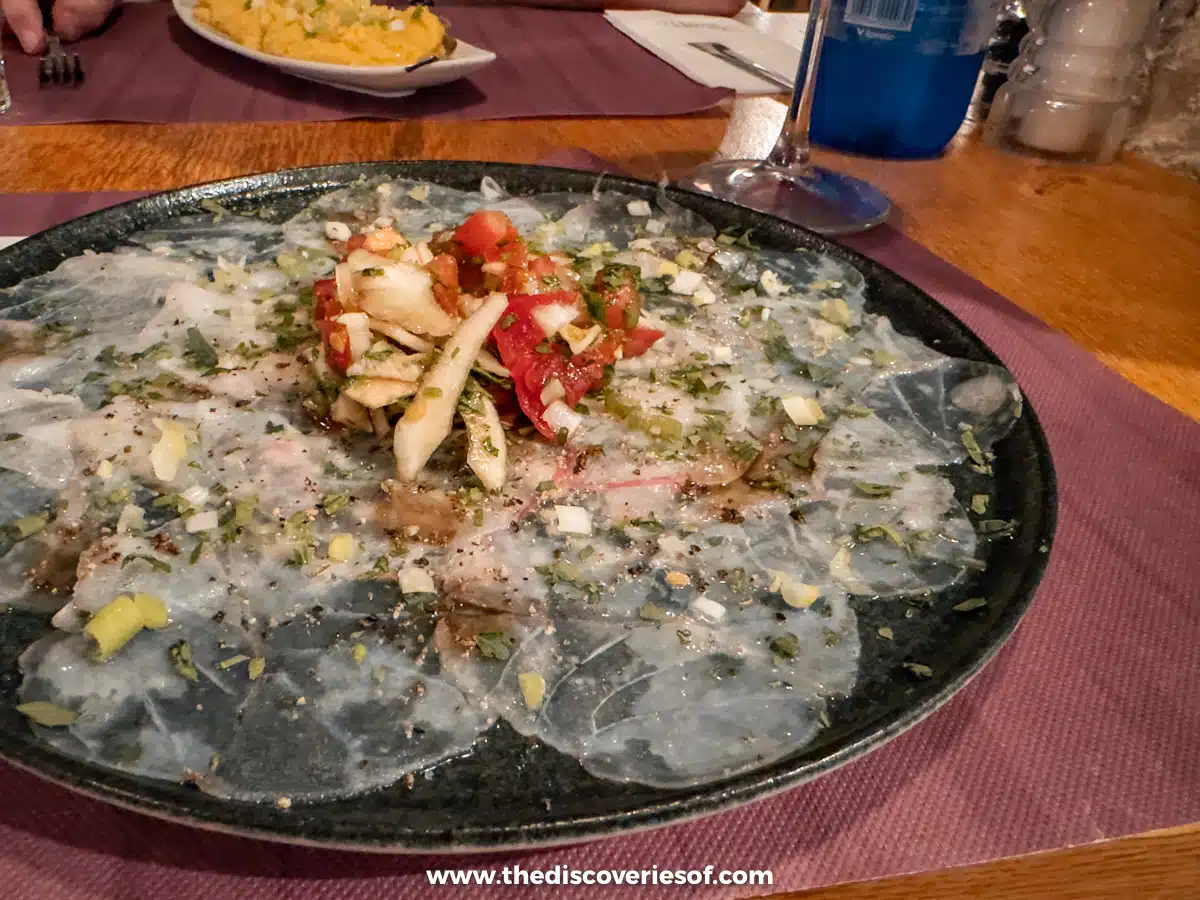
Pollonia is one of the larger towns but somehow still laid-back and not too crowded.
If the name looks familiar, it comes from Apollo, as there are rumours that the Temple of Apollo was once located near the town. It’s a beautiful beachside village with sandy shores dotted with lively bars and restaurants.
I chose to base myself in Pollonia on this trip as I wanted to stay within easy reach of the island’s top sights and in a location with plenty to see and do within walking distance. It was a great decision – particularly because it was within easy walking distance to many of the island’s best bars and restaurants.
The advantage of staying in a more populated area like Pollonia is you don’t need to drive to dinner or sundowners after spending all day outside.
I was surprised by the variety of choices, with anything from sushi at Hanabi Seaside to romantic (and delicious) Italian dinners at Maronne di Milos.
Then there are other finds like the unassuming Deck Milos, which was a great all-rounder on the first floor with nice views of the village. It’s a reliable spot to tuck into burgers, sandwiches, coffee, or juice, and they made a pretty good (if hefty) breakfast.
Stay
You can find some great prices in hotels in this area. We thought our spacious suite at Phos Milos was a great find at €260 per night.
Relive the Discovery of Venus de Milos
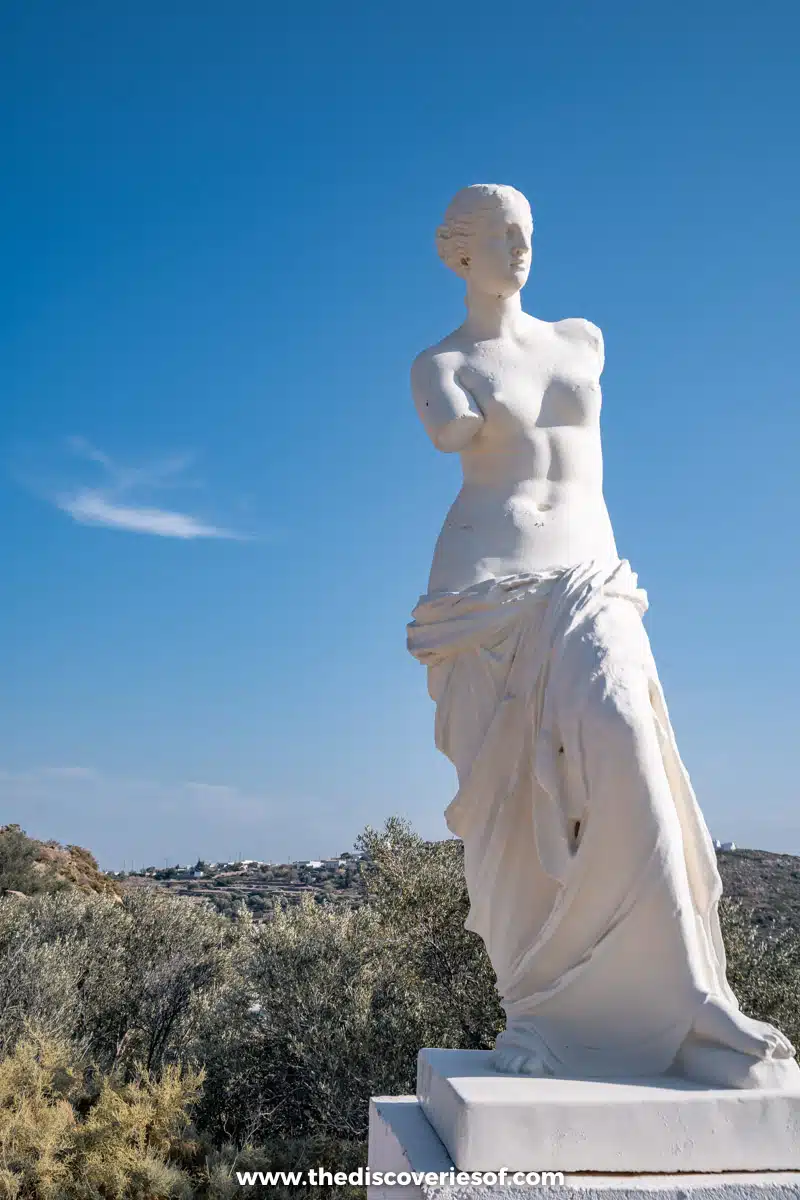
Ever been to the Louvre in Paris? Then you’ve probably seen the 2-metre-high solid marble sculpture of Venus de Milo on display. Bet you never knew that there is quite the story behind its discovery and that you can see a replica of the very place it was discovered in Milos itself.
In fact, the tale of the statue’s passage to Paris it’s a narrative so farcical, you could be forgiven for thinking I was reading the script of a Hollywood caper. But hear me out.
In 1820 a local farmer named George Kentrotas found the abandoned sculpture in his field. He tucked it away – not knowing the importance of what he’d found – until a visiting sailor, Jules Dumont d’Urville, took notice and arranged (via the French ambassador to Turkey) for the French government to purchase the statue.
In the meantime, a village priest also wanted in and begged the farmer to sell it to him so he could give it as a gift to the Sultan of Constantinople. He *almost* succeeded, but a French official saw the statue going onto a ship bound for Istanbul and successfully procured it for the French, transporting it to Paris where it was placed in the Louvre, the very museum it still stands in to this day.
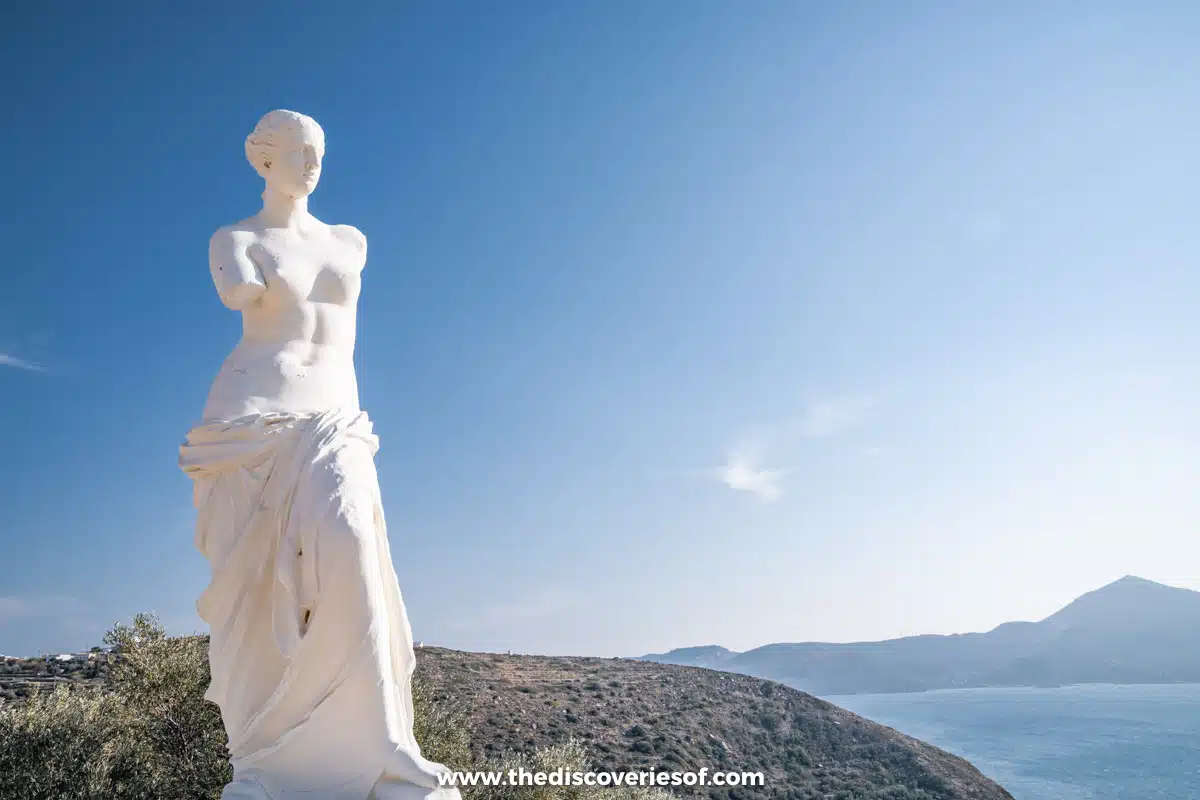
No one knows why, but at some point during the whole farce – either during the transportation of the statue, or during the argument over it, the arms were cut off and lost.
Anyway, all that to say that there’s more to this replica – two metres high and made of over a tonne of solid marble from Paros – than first meets the eye.
Tour the Port Town of Adamas

Adamas will serve as your introduction to the island if you arrive by boat, as it’s home to the island’s main harbour. It’s a lively port town (well, for Milos anyway) that serves as the hub for travel from Santorini and Mykonos (and other destinations) by ferry.
There are lots of bars, restaurants, and a few nightclubs (try Plori) that come alive during the summer months. So, what should you do when you’re here? I have a few suggestions.
First, you need to schedule at least one meal at O! Hamos! Tavern. It really feels like you’re eating in a Greek grandmother’s dining room – with lovely slow-cooked meats and little puff pastries stuffed with salty cheese (divine). And cocktails from the small but adorable courtyard patio at Akri Bar are a must for some of the best views of the Aegean harbour below.
Looking to dig deeper into the island’s history and geology? You can also learn more about the thousands of years of mining for Obsidian and other minerals on the island at Milos Mining Museum, for only €7 with an audio tour.
Visit the Charming Fishing Village of Mandrakia
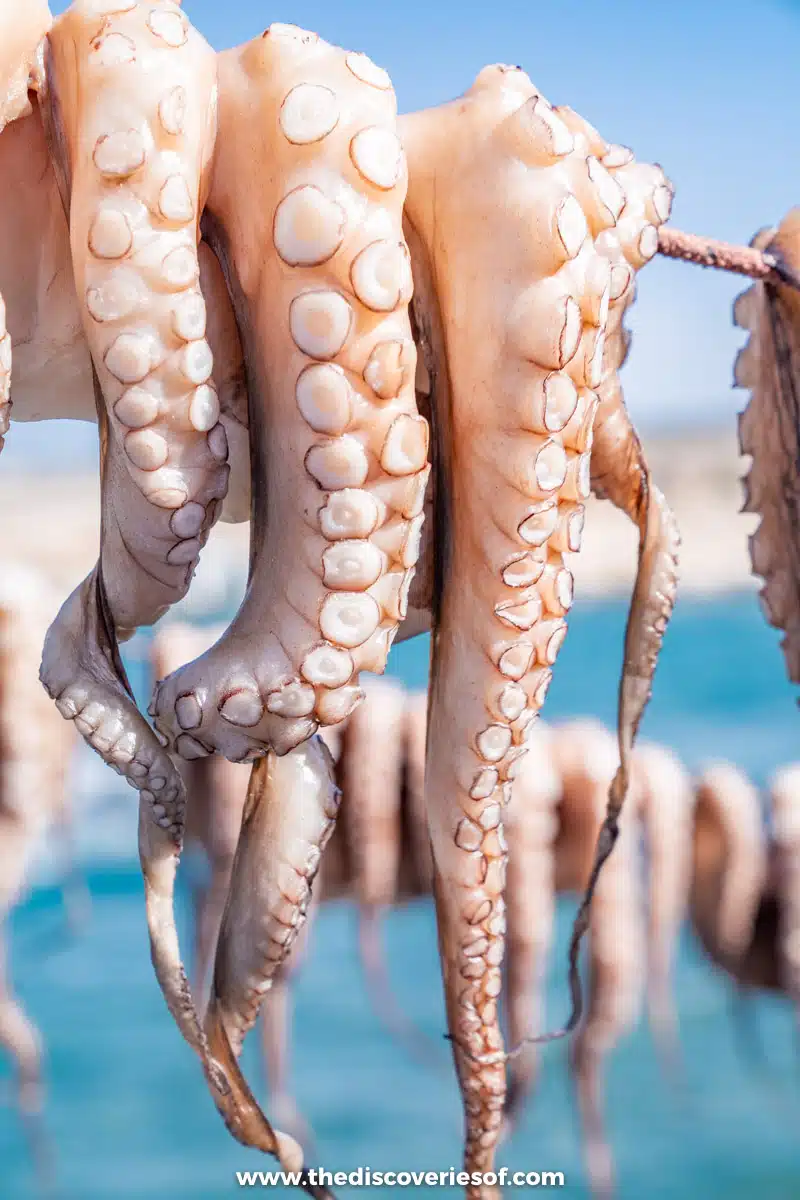
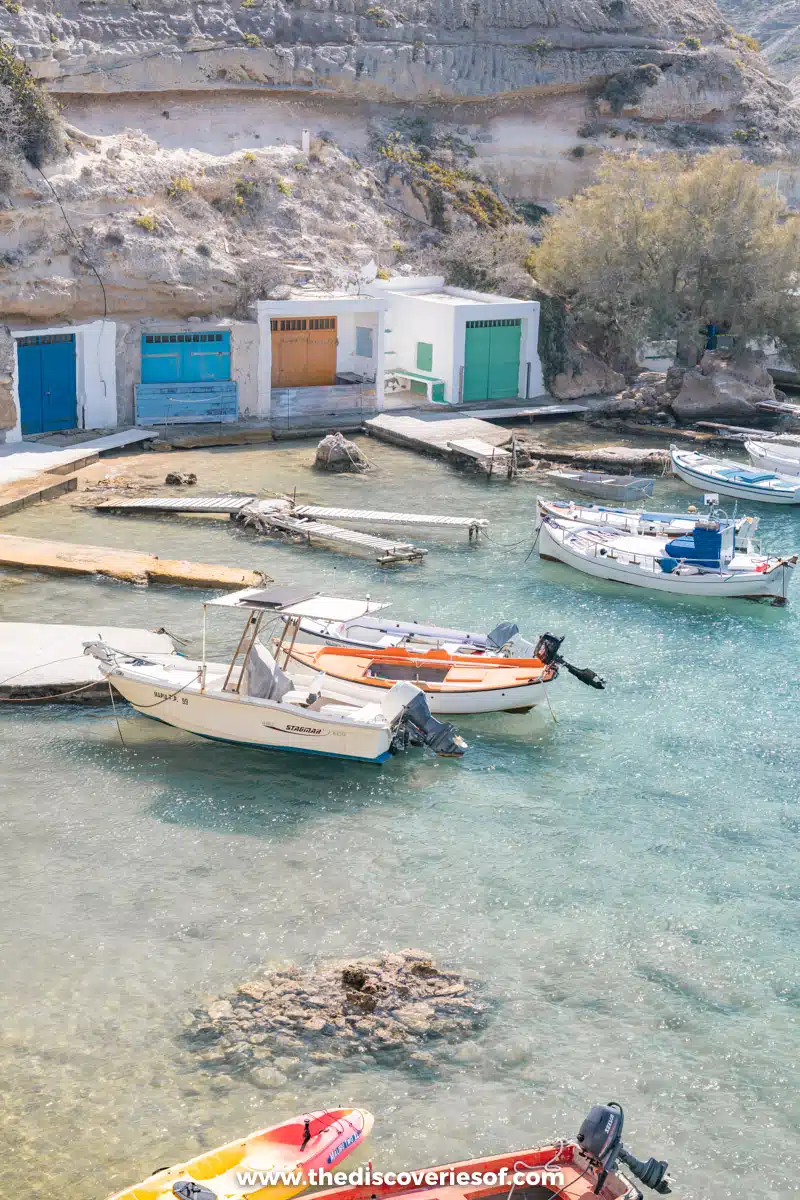
Looking for things to do in Milos that are a bit more off the beaten path? Check out the small fishing village of Mandrakia, home to the stellar seafood restaurant Medusa.
Sure, I mentioned it earlier on in this guide, but Medusa is the main attraction in this quaint village. It’s a charming setting with a white & blue beach house perched above the clear blue waters. Look closely and notice freshly caught octopus drying in the sun.
Mandrakia is an active fishing village, and as charming as it is tiny. But if you perch yourself above the cliffs over the harbour, you can get some stunning shots of the boats lined up in the cove in front of the boathouses (syrmata) etched into the chalky-rocky shores.
You’ll also notice the white-washed orthodox cathedral Zoodohos Pigi, with its bright blue doors and eye-catching bell tower.
Walk Through Milos’ Catacombs
Walking through the Catacombs in Milos may only take a few minutes, but what it lacks in size, it more than makes up for in its history.
The cemetery of the early Christian era dates back sometime between 1AD – 6AD. Thousands of Christians are buried here (some estimate as many as 8,000).
Venture through the subterranean complex of halls and corridors to see the unique tombs inside. There are arched tombs (both in singular stones and paired) and horizontal tombs. You’ll also see floor-pit graves. There are 200 metres in total carved out of the volcanic rock, and what remains is a truly incredible reminder of ancient religions in Greece.
Sadly, a large portion of the catacombs were heavily damaged years ago through looting, erosion, and weather.
Top Tip: Be sure to keep an eye out above ground for the Tomb of the Witness, which is one of the only graves you’ll see outside of the underground catacombs.
Visit the Ancient Theater of Milos
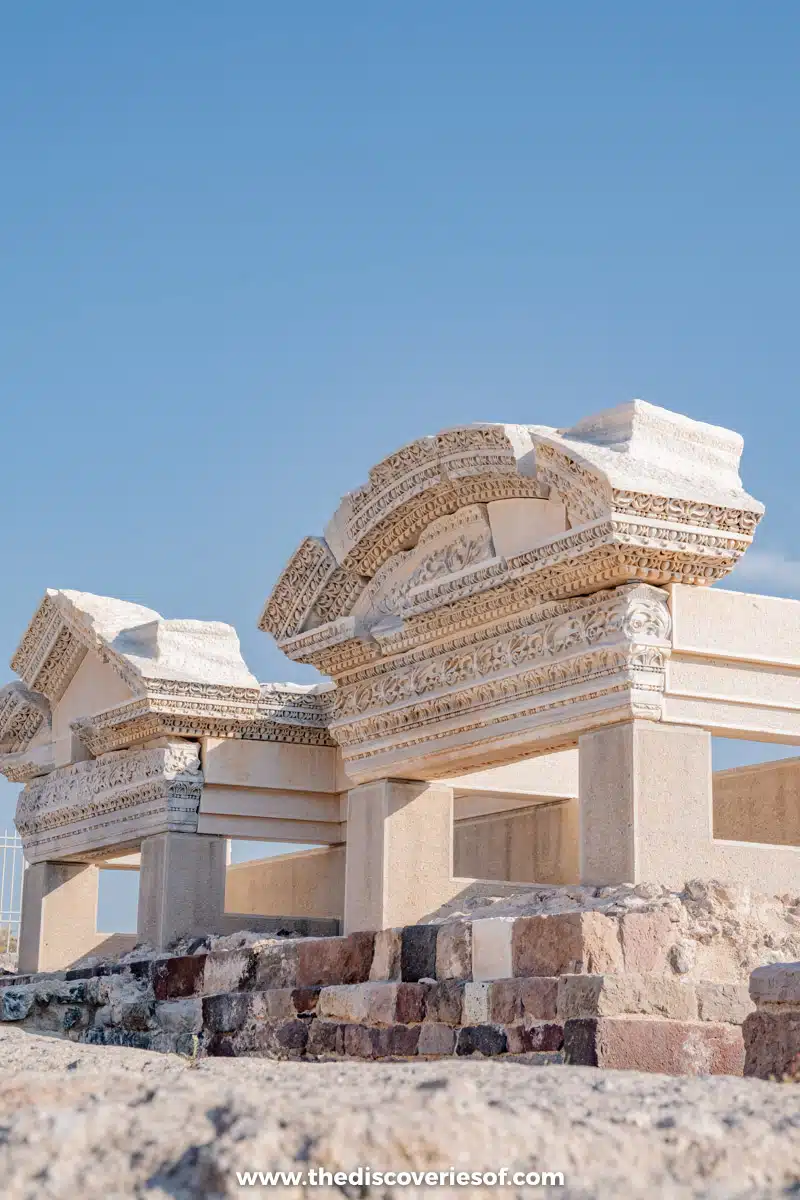
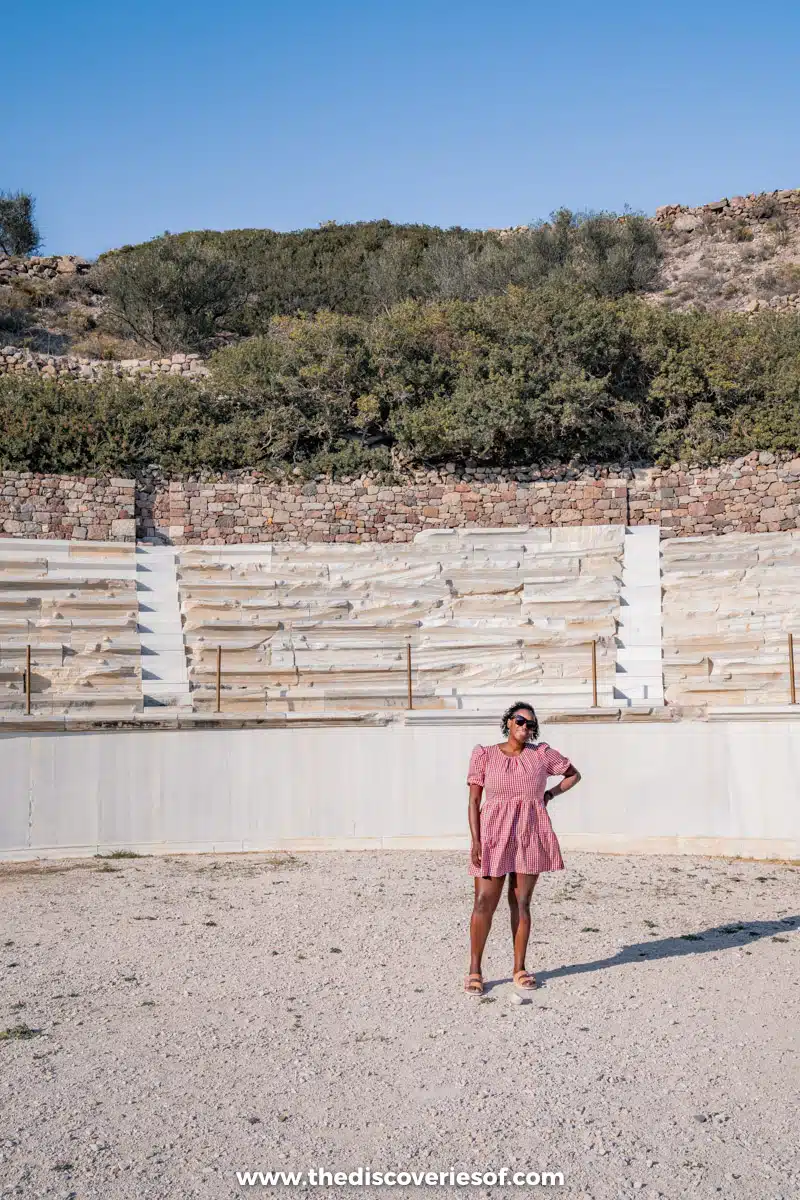
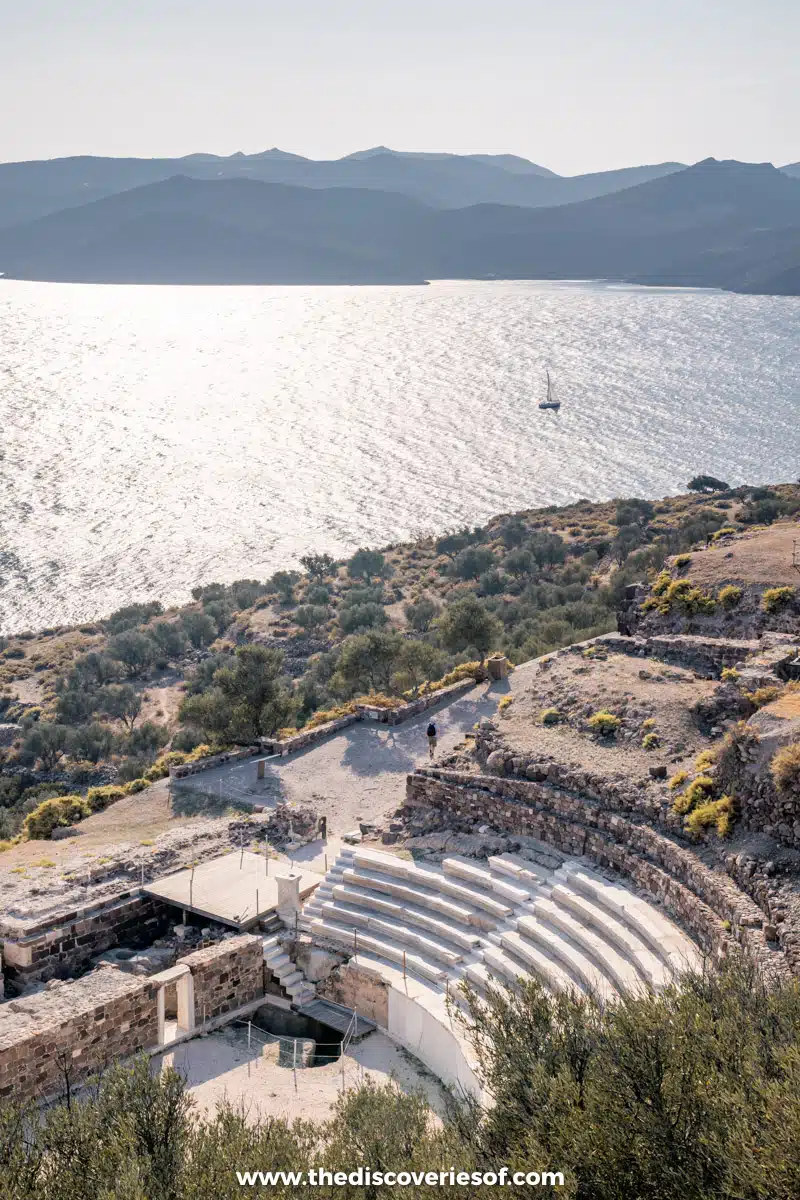
Sitting above a spectacularly pretty stretch of coast, Milos’ Roman Theatre is a quiet spot that not many venture to. You should – not only is it free, but it’s an interesting place to take a deep dive into the island’s Roman connections.
It’s not an amphitheatre, as it’s semicircular rather than circular, but it is one of the best preserved ancient theatres in the Cyclades and an extraordinary reminder of just how long Milos has been inhabited.
The ancient city of Melos dates back to sometime between the 9th century BC and 7th century AD, with years of prosperity, largely due to the obsidian on the island (used to make tools and weapons), and its location between Greece and Crete.
This Roman Theatre overlooking the ancient harbour (Klima today) was constructed from marble sometime between the 1st and 4th centuries AD and used for hundreds of years, most recently as dwellings and workshops in 7 AD.
Excavations of the 7,000-seat theatre began in the early 19th century by German architect Carl Haller, but efforts as recent as 2015 have helped bring the theatre to the pristine condition you see today.
Top Tip
Try out the marvel of ancient acoustics – stand on the stage and whisper, and the acoustics carry the sound to every part of the theatre.
Stroll Through Trypiti
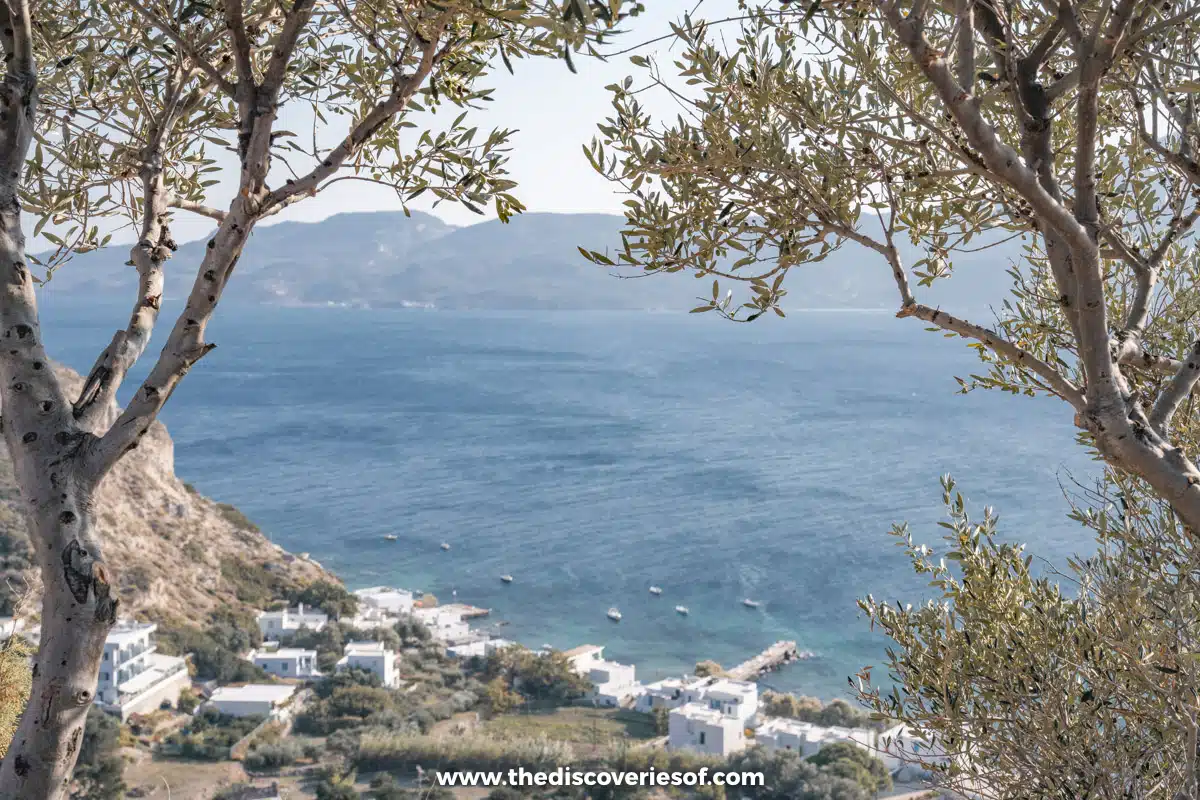
The ancient village of Trypiti sits high up on a hill, overlooking Milos’ ancient harbour. But it’s worth spending a couple of hours getting to know it and its scenic reminders of its history – like the numerous windmills on its white-washed buildings. These were active for decades, processing wheat and other grains for the village.
Nowadays, you’ll mostly find bars, restaurants, and a few hotels in town, along with great views of landmarks like the catacombs from atop the hill.
Self-Guided Hike on a Miloterranean Geo Walk
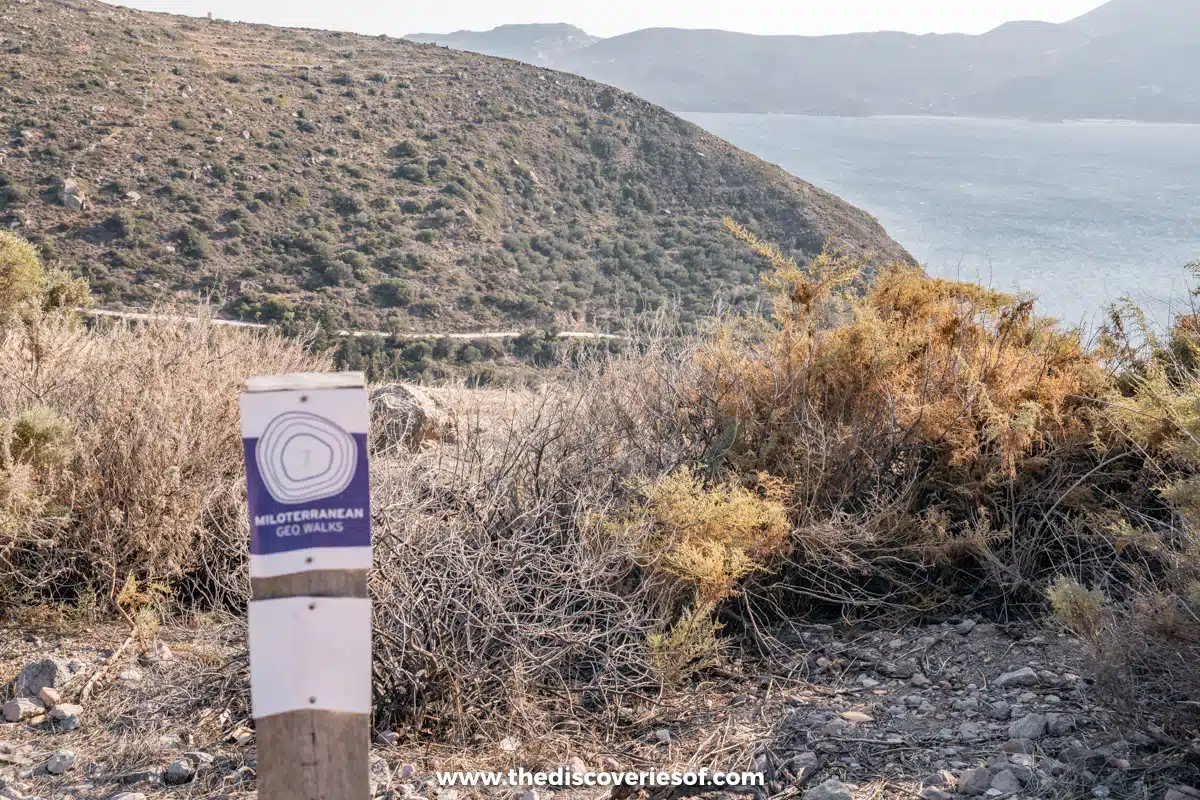
Want to try something completely different? Explore the island via a series of cool self-guided hikes put together by the Milos Mining Museum.
The hikes explore the geology of the island, taking you to spots including the Archaeological Site of Phylakope and the Sulphur Mines.
The Archaeological Site of Phylakope is home to one of Greece’s first-ever cities, and while the site is a bit hard to navigate, it’s pretty interesting to retrace steps from the 5,000-year-old village.
Explore Western Milos
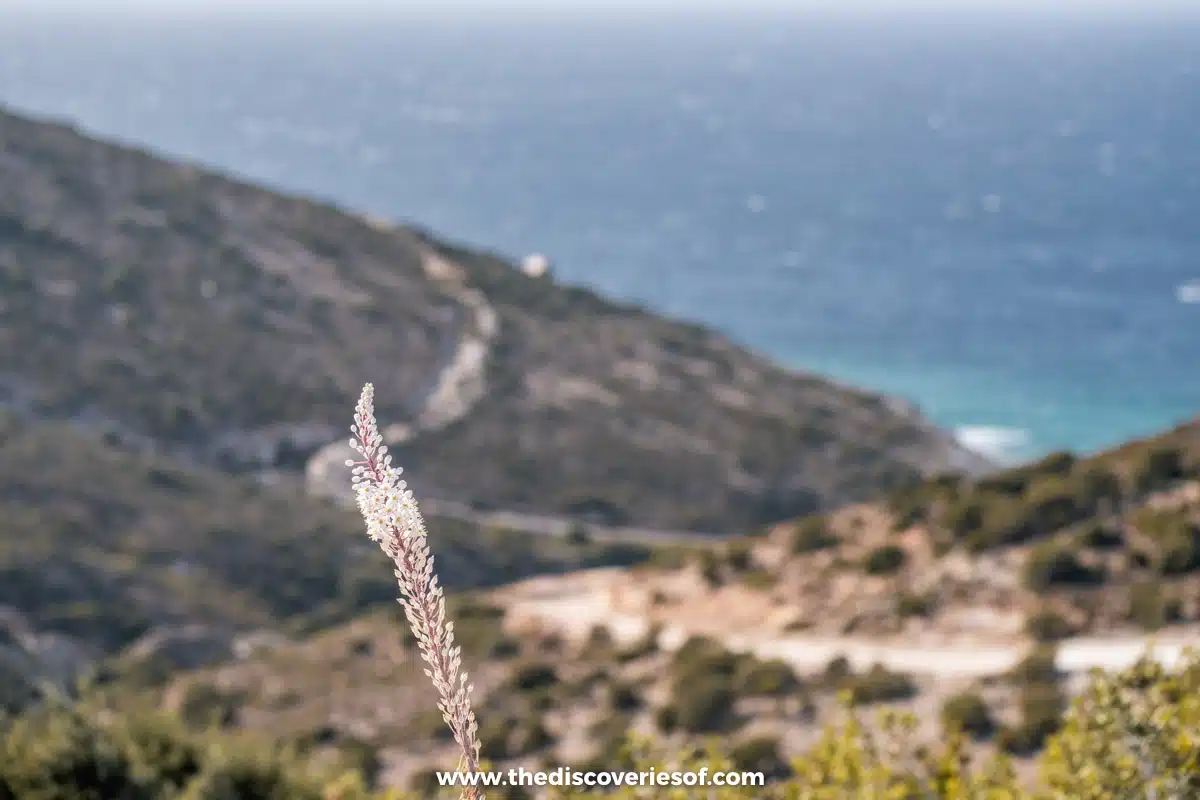

Lots of guides tell you that you need a 4×4 to drive on the western part of the island, which simply isn’t true. Although some of the roads are unpaved, they’re in really good condition, and we had no issues driving on them in our standard rental car.
You do need to watch out, though, as some roads are harder to drive on. We had a handy map that showed the type of road and whether it was paved or unpaved – so we just avoided the rough dirt tracks.
I’m so glad we made it to the west side, as it’s way quieter and incredibly scenic. It’s an area where wild goats roam in numbers 100:1 for every human, even with the smattering of tourists who make it this far over.
So what should you see when you’re here? The Monastery of St John Siderianos is a stunning 16th-century monastery, with a pretty fascinating backstory. Locals apparently hid from pirates inside and willed the door to turn from wood to iron to lock them out.
I couldn’t verify this, as the monastery itself was closed when I visited. It didn’t much matter. Another treasure lay just beyond, reached via a short fork leading down to the coast.
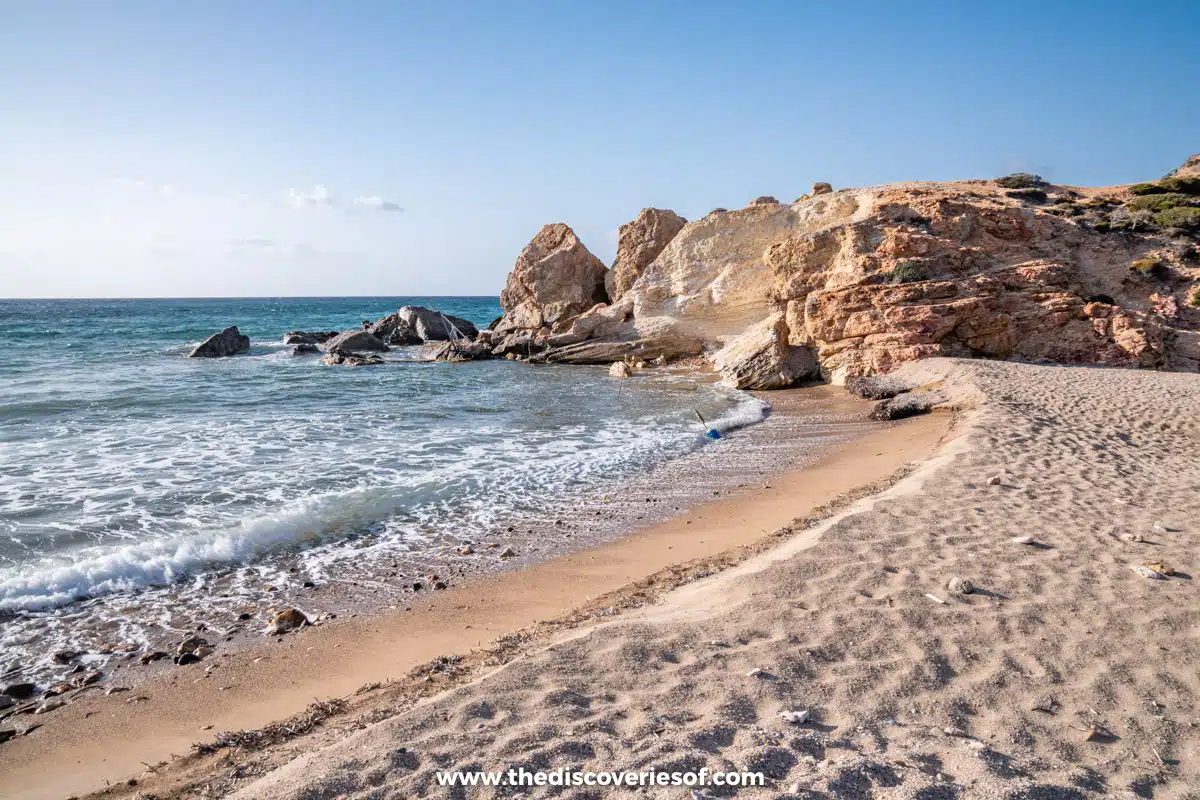
There’s a small (basically deserted) beach with turquoise water and a sort of desolate beauty. The kind with rough-hewn cliffs tumbling into the sea waves crashing (it was a windy day) onto the shore with no one but us to hear them. It might not be as pretty as some beaches on the island, but the drama and isolation set it apart in a class of its own.
Take 4×4 Trip to the Volcano
You can take a 4 x 4 drive through some of the lesser-travelled roads in Milos on a guided tour of the dormant volcano. I didn’t get a chance to do this, but it looked epic. I mean, where else are you going to truck it up to the top of a volcano?
Your expert guides will pick you up around 10 am in Adamas and drive you up the Agia Kyriaki Volcano Crater. Then, you can set out on a hike, where you’ll see some of the most interesting geology on the island.
Look closely (but not too close), and you’ll see the volcanic fumaroles unleashing their power high into the sky.
Practical Tips for Your Milos Trip

Top Tips
- The ferry ride can be quite choppy, and I heard plenty of stories about getting seasick. Take seasickness tablets if that’s likely to be you.
- Personally, I think you should hire a car when you get to Milos. Having your own wheels opens up a lot more of the island to you.
- You can also opt for an ATV, which helps youreach places on dirt roads.
- We found a handy map that showed which roads were paved, which was very helpful in planning our routes. Try and get one on the island, or you can buy one here.
- Most of the best beaches are on the south of the island, besides the otherworldly Sarakiniko Beach.
Getting There
Most visitors fly or take the ferry to Milos. If you take a plane, you’ll need to fly in from Athens (there are no international airports).
The return ferry from Santorini in October set us back €374 for two adults and books out well in advance. Don’t forget to check in online before boarding.
How Long to Visit in Milos?
Spend at least a week in Milos to hike, sightsee, and relax on the beach.
Best Time to Visit
I went in October, and it was lovely, but you’ll have warmer temperatures from May to September. I’d recommend avoiding July and August as this is the peak season for the summer Meltemi winds.
Where Should I Stay in Milos?
Phos Milos (Mid-Range)
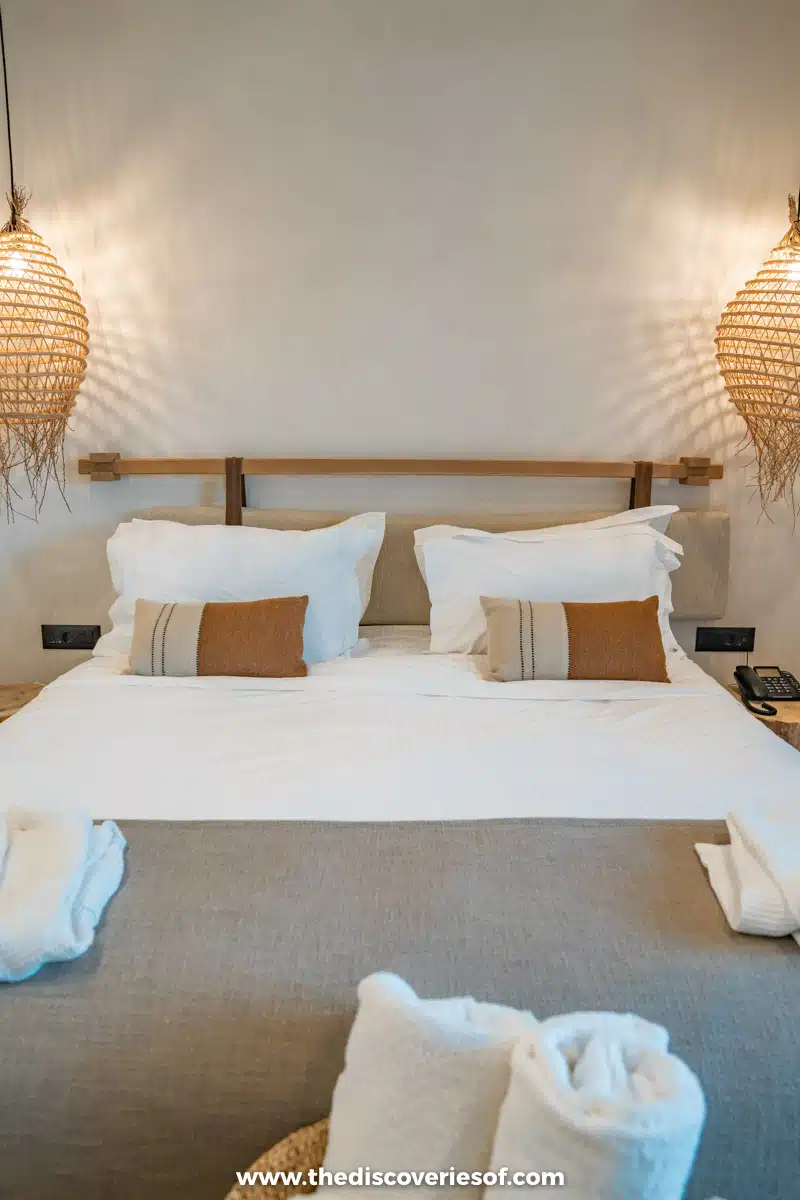
This brand-new hotel features great deals on pared-back, contemporary Greek rooms, with white walls and natural materials like woven lampshades adding a comfortable feel.
Volcano Luxury Suites Milos (Luxury)
Upscale, adults-only accommodations with spa baths on balconies overlooking the ocean in Paliochori.
Map
Read More Milos Guides
- Where to Stay in Milos
- The Insider’s Guide to Sarakiniko Beach
- The Best Restaurants in Milos
- A Complete Guide to Plaka, Milos
- Here’s Exactly What You Need to Know About Visiting Kleftiko
Love This? Save and Share on Pinterest!
